

DIADORA PAGE 35 HAK BAKER PAGE 64 KOLA BOKINNI PAGE 67 ESSENTIALJOURNAL.CO.UK SWITZERLAND'S TALISMANIC MAN BETWEEN THE STICKS ON HIS WORLD CUP HOPES, THE FUTURE OF SWISS FOOTBALL, AND SAVING PENALTIES PAGE 40 FASHIONLIFESTYLECULTURE ISSUE 66 NOVEMBER 2022 66


CREATED & PUBLISHED BY
ESSENTIALSTUDIO.CO.UK


SAM DYSON s.dyson@essentialstudio.co.uk
ISSUE SIXTY-SIX 7 THE EDITOR'S NOTE // 9-25 THE PRIMER 26-27 OTDW: OPPO RENO8 // 29-31 EWAN MCVICAR 32-33 KARDO // 35-37 DIADORA 38-39 JOHAN CRUYFF // 40-47 YANN SOMMER 48-49 HAK BAKER // 50-51 QATAR 52-59 WORLD CUP WONDERS // 60-61 JOE FRIAR 62-63 IWC TOP GUN ROADSHOW // 65-67 MEET THE MAKER 68-69 ANDY ELLIS // 71-73 KOLA BOKINNI 74-75 THE BANSHEES OF INISHERIN 76-83 10 YEARS OF LA MARZOCCO UK // 84-85 MU 86-87 SHIRAKAWA 1958 // 88-89 ESSENTIAL PANTRY 90-96 THE COLUMNS CONTENTS ISSUE SIXTY-SIX Ivan Tisdall-Downes // Oppo // Ewan McVicar // Kardo // Diadora // Tessuti Yann Sommer // Wax // Hak Baker // Rob Pratley // Renuka Odedra // Jonny Owen Elizabeth Helenek // Emily Menzies // Joe Friar // David M. Robinson // IWC Grant Wilson // Sumuyya Khader // Andy Ellis // Kola Bokinni La Marzocco Paul Kelly // Chris Hoy // Holly Kragiopoulos // Amine Moukdi // Cal Smith Tomatin Distillery Co. // Stephen Bremner // Ayo Adeyemi // Rohin Johal Emmy Hallahan // Louis Beneventi ESSENTIALJOURNAL.CO.UK // @ESSENTIALJOURNAL TERMS
Under no circumstances must any part of this publication be reproduced without prior permission of the publisher. Whilst every effort is taken, the publisher shall not be held responsible for any errors. Furthermore, the publisher shall not be held responsible for any advertising material/content. Please also note that
partnership manager
lead designer
features writer
creative director
published
5
& CONDITIONS
the views and opinions written within this publication do not necessarily represent the views and opinions of the publisher. All prices and details stated within this publication are correct at the time of print, however these are subject to change and the publisher shall not be held responsible for these. Third party contributors own exclusive copyright to their own material that they have submitted as part of the publi cation. All rights reserved. contributors THE ESSENTIAL JOURNAL STAFF
EVIE FRIAR evie.friar@essentialstudio.co.uk
BETH BENNETT b.bennett@essentialstudio.co.uk
THOMAS SUMNER t.sumner@essentialstudio.co.uk editor JAI MCINTOSH j.mcintosh@essentialstudio.co.uk
by ESSENTIAL STUDIO // ESSENTIALSTUDIO.CO.UK



Specialist Vehicle Insurance
fully comprehensive insurance designed especially for specialist vehicle owners mr-bloor.co.uk
A
THE COVER IMAGE
THE COVER IMAGE
Simon Kuper


THE EDITOR'S NOTE
The World Cup promotes a global indulgence in nostalgia, shrouded in colour, offering the fruits of glory. An experience and event that captivates more people than any other. The competition ties the contemporary to the past, encouraging a sense of unification and togetherness that, whilst it lasts, acts as national nectar. That said, when the 2018 Russia World Cup came around, critics abound protested at Putin’s effective sportswashing tactics and the repeated reports of worker deaths throughout various pre-tournaments construction projects - let alone the outrage that North Korean workers had been used as cheap and disposable labour across the Zenit Arena project - a scandal that Josimar’s Håvard Melnæs named The Slaves of St Petersburg. The year before the Russian World Cup, in 2017, FIFA pledged their Human Rights Policy to “go beyond its responsibility to respect human rights'' via various “measures to promote the protection of human rights and positively contribute to their enjoyment.” This pledge was clearly ignored in 2018 and this trend appears to have continued into Qatar 2022. Amnesty International titled the 2022 event a “World Cup of Shame”, exposing the staggering numbers behind construction projects with an estimated 1.7 million migrant workers comprising 90% of the entire Qatari World Cup workforce. Many of these have suffered with underpayment, poor working and living conditions, and passport confiscations. Equally, there have been a collection of LGBTQ+ campaign groups questioning the validity of a World Cup being held in a country where their sense of being is under threat. Thus, the World Cup not only houses last minute drama, the tournament is a base of global power and influence. It is now well known that Qatari ministers veiled British ministers with gifts that The Observer’s Shanti Das uncovered to be of a value “greater than the amount spent by the 15 other countries whose governments made donations to British MPs combined.” For the sake of brevity, I need not detail the extent to which this World Cup is without the question the most ecologically damaging footballing event of all time. Sport has always been a tranquiliser, a true entertainer, the controller of the crowd. Whilst the variety of issues cloud this World Cup and the previous one, there is scope to celebrate, there are still reasons to unite, perhaps now more so than ever. It is just worth keeping in mind that, regardless of your nations’ performance, there may be a few issues bigger than the beautiful game.
JAI MCINTOSH EDITOR
THE EDITOR'S NOTE
‘THE WORLD CUP IS THE SORT OF COMMON PROJECT THAT OTHERWISE BARELY EXISTS IN MODERN SOCIETY.’
pictured YANN SOMMER photographed by SAMY EBNETER (SFA) interview JAI MCINTOSH
pictured YANN SOMMER photographed by SAMY EBNETER (SFA) interview
interview JAI MCINTOSH
THE EDITOR'S NOTE
7

FIVE IN FIVE: BEST FOOTBALL BOOKS
With the World Cup hitting our screens this November and taking up the airwaves for the rest of the year, we're assigning time away from the TV and suggesting five of the best football books for some supple mentary reading.
THE BOOK THAT CHANGED FOOTBALL THE EXPECTED GOALS PHILOSOPHY

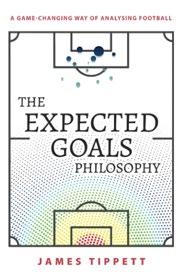 BY JAMES TIPPETT
BY JAMES TIPPETT
CORRUPTION IN THE BEAUTIFUL GAME THE FALL OF THE HOUSE OF FIFA
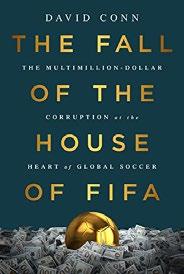
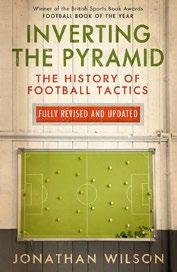 BY DAVID CONN
BY DAVID CONN
THE HISTORY OF FOOTBALL TACTICS INVERTING THE PYRAMIND
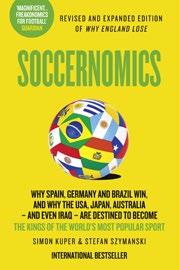 BY JONATHAN WILSON
BY JONATHAN WILSON
THE PREMIER LEAGUE CAUGHT UP THE MIXER
BY MICHAEL COX
ANSWERS TO FOOTBALL'S BIGGEST QUESTIONS SOCCERNOMICS
BY SIMON KUPER & STEFAN SZYMANSKI
THE PRIMER
THE PRIMER
1
9
WHAT WE'RE WATCHING BAD SISTERS
Somewhere in Ireland, a woman files an insurance claim. Inconsequential, this happens every day, doesn’t it? Yet, in the twisting, turbulent world of Merman Productions’ Bad Sisters, this very action unlocks a family drama you won’t want to stop watching.
Sharon Horgan plays Eva, and is flanked by Becka (Eve Hewson), Ursula (Eva Birthistle), Bibi (Sarah Green), and Grace (Anne-Marie Duff), who lead a complex tale of revenge as these Bad Sisters finally retaliate against Grace’s abusive husband John Paul, a wickedly malicious serve from Claes Bang.

The show is artfully split across two time lines, in a way that avoids all the trappings that lesser shows have succumbed to. In the present day, we witness an exhausted insurance man and his reluctant broth er (the masterful Brian Gleeson and the effervescent Daryl McCormack) as they try to uncover some foul play in JP’s death so they don’t have to pay out the moun tainous life insurance policy. Concurrently, in the past, we see Eva, Becka, Ursula and Bibi plot to kill him to save Grace from his ensnaring evil.
Bad Sisters is slick, stylish, and unapolo getically Irish. Against a soundtrack of PJ Harvey and in the thick woods of Dublin, we found ourselves laughing and crying
alongside these sisters, as even in their most outlandish premise, they’re rooted in comic realism and a familiar sense of des peration. The energy is addictive, the mys tery thrilling, the supporting cast dazzling, and, which I believe to be its most remark able feat, the show never tires. There is never a point in its impressive ten episode run that it feels as though it’s running out of steam, like the tension is waning, and the plot becoming too outlandish. Every minute is carefully constructed with effec tive efficiency to ramp up the stakes, unveil more darkness, and make you laugh even in the face of such wickedness.
And in this wickedness, we’re invited in. The show smartly utilises the ongoing motif of eyes, reminding us we’re no differ ent to voyeurs in a private family affair. In watching, we are then imbued with a sense of responsibility. Teased from an impres sive use of a taxidermy eye to a foreboding statuette of the Virgin Mary on a car dash board, the show states that even should we become blind, lose an eye, or simply close our eyes from it, we’ve witnessed the ac tions of each character. It, then, becomes our moral crisis and we’re thrust into the very quandaries that the Garvey Sisters encounter each day.
So, get your own eyes on it. Become com plicit in one way or another. We here at EJ don’t reckon we’ll let this one go for a while.
THE PRIMER
THE PRIMER
2
10
Images courtesy of Apple


THE PRIMER
11
THE PRIMER

THE PRIMER THE
3 12
PRIMER
WHAT WE'RE LOOKING AT THANDIWE MURIU
Thandiwe Muriu is a photographer born and raised in Nairobi, Kenya. As a female artist operating in a previously male-dominated field, she is passionate about celebrat ing and empowering her fellow women. In her CAMO series, Thandiwe showcases Africa’s unique mix of vibrant cultures, textiles and beauty norms. Through her work she celebrates her African heritage and tackles impor tant issues such as identity and self-perception using the rich colours and vibrancy the continent is so well known for. Drawing inspiration from African textiles, everyday objects, and traditional hairstyles, Thandiwe explores how the individual can lose their identity to culture. In her work she not only explores who she is as an artist, but also as a black woman.
@THANDIWE_MURIU
THE PRIMER THE PRIMER 13
WHAT WE'RE LOOKING FORWARD TO KENDAL MOUNTAIN FESTIVAL

17 - 20 November 2022
Kendal Mountain Festival is a platform for inspiration, discovery and connection. Taking place from Thursday 17 - Sunday 20 Novem ber 2022, this year's festival is the biggest it's ever been, bringing us an extensive pro gramme of events. Soak up the atmosphere; in the cinema, on the trail run, in the bar, up on stage, on the dance floor, or explore the beating heart of the festival at the tented Basecamp village. Wherever you are in the melee, it is electric.
This year the festival includes a huge range of feature films and collections. Travel to Greenland by kayak and climb the world’s greatest sea stacks; see the spectacular story of a diehard group of Cuban surfers rising up against their government on an island where surfing is outlawed; and hop on your bike with 17 year-old Jessie on a 300-mile campaign to reach the COP26 climate summit.
The weekend kicks off with renowned environ mentalist George Monbiot to ask the ques tion: what if there was a way to stop climate change and end global hunger at the same time? On Friday, join award-winning filmmak er and zoologist Roxy Furman on stage with her latest films, ‘Swimming with Giants’ and 'Voices of the Forest' documenting the lives of the endangered whale shark and Geoffrey's spider monkey.
This year, Kendal Mountain Festival are de lighted to welcome the world’s greatest living explorer, Sir Ranulph Fiennes, for a unique and exclusive event as he offers a personal account of his life; from his childhood misde meanours at school and early expeditions, right through the Transglobe Expedition to his current activities.
THE PRIMER THE PRIMER 4
14
For tickets and full programme listings visit: tickets.kendalmountainfestival.com
WHAT WE'RE LISTENING TO KING GIZZARD & THE LIZARD WIZARD ANNOUNCE THREE NEW ALBUMS TO BE RELEASED IN OCTOBER
Australia’s prolific atom-splitting polymaths King Gizzard & The Lizard Wizard exceed even the most hyperbolic projections and announce the upcoming release of three new albums, all set for flight during the month of October via their own KGLW label. The first to drop will be Ice, Death, Planets, Lungs, Mushrooms And Lava, out October 7th. Following that will be Laminated Denim, dropping somewhat unconventionally on October 12th, a Wednes day. Finally, on October 28th the band will release Changes, their 5th album of the year.

THE PRIMER
@KINGGIZZARD
THE PRIMER
5 15

6 THE PRIMER
16
THE PRIMER
WHERE WE'RE EATING TERRE
Vincent Crepel grew up in the French Pyrenees and trained in the Basque Country. He worked at the three Michelin-starred Arzak in San Sebastian, at Hotel de Ville Crissier in Switzerland and with An dre Chiang in Singapore before opening his own restaurant, Porte12, in Paris. Now, Chef Vincent Crepel has opened his first solo venture outside of his native France, Terre, a modern restaurant housed with in a 17th-century manor house at 5-star Castlemartyr estate in Ireland.

“From the first moment I saw the green fields of Ireland surrounded by its spectacular coastline, I have felt a connection with the land and its people, drawn energy from the sea, and inspiration from its boun ty,” explains Vincent. “At Terre my hope is to bring you on a special journey, and to share with you my very personal vision of a modern restaurant experience.”
Vincent’s Terre utilises ingredients from the Irish larder whilst draw ing on his experience in France, the Basque Country and Asia. Dinner begins with aperitifs overlooking the estate’s landscaped gardens, a tour of the kitchen with champagne and snacks and an intimate look into the dry ageing fridges and fermentation rooms before sitting down to dine. The wine will be given the same prominence as the food, curated from a list of small scale, family-owned producers using low intervention methods to produce biodynamic and organic wines.
@TERRE_RESTAURANT_ THE PRIMER THE
17
PRIMER
WHERE WE'RE STAYING UNYOKED
Australian born nature company Unyoked are leading the charge when it comes to detaching from society, and taking a well deserved rest surrounded by the beauty of the natural environment. Unyoked aims to promote relaxation, stimulate creativity, and enhance your connections. Now, with multiple spots opening throughout the UK, an Unyoked stay looks like the ideal winter getaway.
Keep your eyes on EJ67 for a full review!

THE PRIMER
THE PRIMER
7 18
WHAT'S ON OUR FEET CONVERSE
As Converse continues to push its boundaries, a new trio of silhou ettes debuts elements of utility and comfort for versatile and edgy styling. One stand-out style for us is the Chuck 70 AT-CX which is inspired by Converse’s outdoor heritage and is built to deliver a bold stance and lightweight comfort, powered by CX foam. Boasting sleek lines, it is built up for longer lasting comfort with intentional crafts manship, nuanced tooling and bolstered, but subtle, functionality.
Shop the Chuck 70 AT-CX now at converse.com
THE PRIMER

THE PRIMER
8 19

THE PRIMER
20
THE PRIMER
WHAT WE'VE BEEN COOKING MARMITE BEURRE BLANC WITH BROCCOLI STALK & MARMITE PANGRATTATO
INGREDIENTS
Marmite Buerre Blanc
100g 3g 1 50ml 50ml 7g 25g 150g 50g
Sliced white onion
Dried mushrooms such as porcini
Small bay leaf White wine vinegar White wine Marmite Hot water Double cream Butter
RECIPE BY IVAN TISDALL-DOWNES
METHOD
Sweat the sliced white onion in a small saucepan along with the dried mushrooms and bay leaf. Once translucent add wine & vinegar followed by 5g of the marmite dissolved in the hot water.
Reduce this mixture over a medium heat by two thirds. Remove the bay leaf and then add cream and reduce by a further two thirds.
Pass this cream mixture through a fine sieve and then back into a clean small saucepan.
Marmite
Pangrattato
Butter
Stale marmite Dry (old) bread, blitzed into crumbs
Melt the butter in a small pan until foaming. Whisk in the marmite and then add the bread.
Place the pan over the lowest heat and slowly emul sify the butter into the cream mixture with a whisk, followed by the remaining 2gs of marmite. Set aside and keep warm until ready to serve. 40g 1 tsp 50g
Continue to cook until the bread is golden brown and crispy, ensuring you are stirring frequently so the marmite doesn’t catch on the bottom of the pan.
Broccoli Stalk
1 1 tsp
Piece of broccoli stalk, halved (30-40g) Honey
Peel the outer layer of the broccoli stalk to expose the tender flesh beneath.
Steam over a pan for 6 minutes. Remove from the pan, brush with honey then season with sea salt.
To plate, place the piece of broccoli stalk in a bowl and surround with the marmite Beurre Blanc before sprinkling with the pangrattato.
THE PRIMER
9 THE PRIMER
@ivanjd // @eatnative
21
WHAT WE'RE WEARING
"At Hummel, we believe that sport should bring people together. And when it doesn’t, we are eager to speak up and make a statement. That’s also why the new Denmark jerseys for the upcoming World Cup have been designed as a protest against Qatar and its human rights record.
We’ve toned down all the details – including our own hummel logo and chevrons - be cause even though we love football and the feeling of togetherness it gives us, we don’t wish to be visible during a tournament that has cost several people their lives.
We’re immensely proud of our history with the Danish national team, and we support them all the way. However, that isn’t the same as supporting Qatar as a host nation.
In fact, we have made Denmark’s third jersey all black to honour the migrant workers that have died building Qatar’s World Cup stadiums, as well as the families left behind."
You can also read more about the new kits through this FAQ: hummel.net/wcjersey22-faq.html

THE PRIMER THE PRIMER 10 22
DENMARK'S NATIONAL TEAM KIT BY HUMMEL
THE PRIMER



THE
PRIMER
23

11
24
PHOTOGRAPHY JOHN CAIRNS
WHO WE'RE TALKING TO DAN FREEDMAN
Like most young boys, for Dan Freedman, football acted as a safe space. In the sport, Dan found a way to connect with his father, explore his creativity, and comprehend all the demise and drudgery life had to offer. Often found on the pitch at school, Dan found solace in life’s tough times by kicking the beaten up ball around.
Dan remarks how he’d always loved foot ball, but was never ‘quite’ good enough to be professional. However, he clung to it as a form of expression, as a safe space, and soon enough it became his way into becoming a professional writer. He did two stays with England’s World Cup Squad as an FA managing director, being part of their official team. During this time, he was able to interview an all-manner of players, write about their experiences, and grow an even deeper appreciation for the game in a literary way.
It’s during this time that Dan began to con ceptualise what would go on to be his very successful children’s book series: Jamie Johnson. A tale that weaves the pubescent angst and life struggles with an aspiration al young footballer. ‘From the schoolyard to the Premier League,’ Dan remarks of the journey.
“At the heart of it though,” Dan says, “It’s a story about a kid desperate to prove something to himself, to be more than the struggles he’s facing, to be more than what he’s given. Jamie Johnson takes hold of what hand he’s been dealt and flips the deck, becoming someone great.”
Which is an important thing for young boys to read, of course. We’re not one to gender the literature but the audience of ‘Jamie Johnson’ has skewed towards young males for a while. The reason for this is obvious; as Dan says, it can be a struggle to keep young boys engaged in books, but if they’re reading about another passion, it keeps them hooked enough that when it comes to exploring deeper themes or deeper ideas, they’re more receptive to it.
This goes beyond literature too. The players on the field now have more of a platform than before and Dan is eager to discuss how it allows for young men to become engaged in empathetic political movements.
“If a young boy turns on the TV and sees a politician talking about a new law or argu ing against a government reform, they’re probably going to turn it over; but if they turn on the TV and see Marcus Rashford campaigning for access to free school meals, they’re getting engaged, they’re getting involved. Of course, there’s issues that can arise from that but the players now are more trained in media than they used to be, they understand what their privilege can do. They try to do the right thing and seeing that gets young men involved from a younger age.”
“Nelson Mandela said that, ‘Football and music are the two most compelling ways to bring people together,’ and he was right. Football, I think, has the power to enact the most change.”
@danfreedman_99 25
WORDS BY JAI MCINTOSH IMAGES COURTESY OF OPPO

ONE THING DONE WELL
OPPO RENO8
ONE THING DONE WELL OPPO RENO8 OPPO RENO8 26
Founded in 2004 in Dongguan China, Oppo has continually grown into a feasi ble, high-quality non-Apple option. Howev er, simply being an electronics company that produces high-quality mobile phones is not the most exhilarating story in and of itself. That being said, it is the experience of that use, their confidence and trust in their product, and their willingness to allow us to test in any way we see fit that enticed both myself and EJ designer Chris Gerrard to see what they had to offer.
Oppo kindly invited us to Liverpool’s Champions League home match against Rangers with the challenge of extensively testing the phone, gauging responses from people there, and creating various pieces of short-form or image-based con tent purely for us to see the quality for ourselves.
When a brand offers something like this, you know instantly that they are confident. What we quickly discovered was that their confidence is completely justified. Of course, most of us will be regular users of Apple products, such is contemporary life. Once I managed to adapt to the Android layout, I found the Oppo Reno8 to be pleasant to hold, with excellent screen clarity, and a camera as good as the very best phone cameras on the market. The reason for this is that the 4K Ultra HDR Video and AutoFocus Smart Selfie camera is one of the crown ing glories of the Reno8. Add to this a 6.7" Ultra-Clear AMOLED Screen, you’re all set to capture images and videos in per fect quality.
In addition to this, I received my Oppo Reno8 a few hours before the game.

As I plugged it in to charge, slightly anx ious with the thought that I may be late for the match due to charging times. Again, my qualm was almost instantly resolved. The Reno8 not only professes, but deliv ers on their promise that the super-fast charging element on their phone can reach 50% charge in 11 minutes.
In terms of feel, the Reno8 combines a weight indicative of quality without being bulky or overbearing, whilst the physical quality of the material is highly impres sive. At this point, it is worth mentioning that this review is not glowing because we were able to attend a football match, al though that was a very welcome perk. We, at EJ, like to recommend products that we actually believe in. The Reno8 is certainly one of them.
oppo.com/uk 27

BRING THE CAFÉ HOME. UK.LAMARZOCCOHOME.COM/LINEA.MICRA LINEA MICRA
"
INTERVIEW
BY JAKE NOLAN PHOTOGRAPHY BY TOM O’DONOGHUE
"
I used to run my own nights and raves back home in Ayre. I used to go on the dancefloor and thank every single person and nothing's changed.


I used to and raves
I used to and thank and nothing's
29
JN Ewan, tell us what we are wearing today, who we are shooting for and where we are?
EM Today we're in Motion in Bristol which is one of my favourite clubs in the UK, an absolute screamer, and I'm filming with Tessuti for Paul Smith and aye, it’s pretty mental.
JN Tell us about what to expect from Handpicked.
EM So this was my first proper year tour ing in the UK. I've been in Australia and New Zealand, Ireland, Spain, playing in Amsterdam, and the more I’ve toured, I'm seeing different club nights in different cities.
I was like, ‘Oh what if I start my own one?’ and put my own spin on it with the knowl edge I have for music and hopefully with the fans that I've got now, that kind of new gen fans and ravers that have come out, I want to expose them to the music I was exposed to when I was that age so when they come to Handpicked, it’s me picking the line-up making it flow the best I can for the night.

When they come, I hope they get their minds blown. The first one is in Motion. I can't even wait, mate, I’m so excited.
JN I see Scottish dance music royalty Optimo are on the line up, can you explain the influence they have had on dance music culture?
EM So Optimo have been a total cultural behemoth, not just in Scotland, but they've affected many parts of the world just through their creativity and the way they run their label. They, for me, were one of the best labels I had growing up and then I signed with them at the start of the year. I got the logo tattooed on my ribs before a show in Norwich the other week.
I asked them to play, not sure they would say yes, but they were keen to get in volved. I was cheeky enough to ask them to go back-to-back, so I’m going to go back-to-back with two of my heroes. They’re just amazing, they never ask for anything in return, they just go about their business and do so much for Scotland and the UK, and I’m so excited, I can’t believe they’re playing for me either. I was sitting down the other night watching their Boiler Room in Australia and I was saying, ‘Oh my god I can't believe I'm going to play with
him.’ Just mental, that's a dream come true man.
JN First one's in Bristol's famous Motion, good memories of playing here before?
EM Good memories of Bristol? Yeah, I played one of my first shows of the year after the second run of Covid. I think it was January and I was playing after Dan Shake; 3 'til 5 in the morning, mad shift. This is my second time here, putting on my own night! I’m buzzing mate, I can’t believe we’re doing this, it’s mint.
JN What do you look for in a crowd?
EM So, I’ve been doing all the festivals around the UK this year, I’ve been to Ibiza 6 times and that, and in the line-ups that I’ve played on, they’re not necessarily who I’ve seen when I was younger. I want to see bemused faces out there when Optimo plays, Shannen SP is amazing as well. I’ve got a full line-up of Scottish DJs too. I’ll be wandering around the room the whole night, and I just want to see folk looking around like, ‘What’s going on man, this is mental’ – that’s what I’m looking for in the crowd tomorrow.
JN What shall we expect from your set?
EM Something different; I don't want folk to come to Ewan McVicar’s Handpicked and expect me to play what I played at Cream fields or what I played at Parklife.
I did my first ‘All Night Long’ at the start of the year at Sub Club, and when I played there were 480 people who came and heard me play the way I’ve never played before. It brings out the best in me; Motion is the same. So, when they come here, I’m not going to play what I usually play and yeah that pisses folk off, but I want to show them a different side to where my roots are in this scene.
JN What does a typical gig day look like?
EM My little brother Rory is my tour man ager. He’ll wake me up and he’s like, 'Right mate we need to go,' and my eyes will be stuck together. So usually, the full day we will be travelling; we get there at night and we don't even get to see the place we’re playing.
Typical gig day for Handpicked is different because I’m already here which is decent as all my mates are coming down from Scotland. So I'll have a pint with them to night, good sleep, wake up tomorrow, play some tunes.
I’m just going to be wandering about talking to everybody and thanking them for coming and supporting me. It’s my own night. It's a bit different; there will be a personal touch. You see folks see people on the big stage at a big festival and think, ‘Oh we can’t talk to him, he’s that far away,' but then when it's something like this, it's more personal.
30
I used to run my own nights and raves back home in Ayre and I used to go on the dancefloor and thank every single person and nothing's changed. I’ve not changed as a person even though this has all hap pened. I can’t wait to just mingle with folk and talk to them and get in touch with the fans again.
JN And… what about the day after a gig?
EM It depends on where you are; if it’s in Ibiza, it’s an absolute shambles. Someone sent me a generic TikTok taken at the airport in Ibiza; they'd videoed everybody like spread out across the airport. Mate, the first person on that video is me, they’ve absolutely done me. It just depends how heavy it goes.
Motion is on 'til 5, all my mates are coming down from Scotland and we’ll probably still be drinking 'til like 9am the next day. I don’t know, it’s usually a mess.

When I was in Australia, I had a show Fri day, Saturday, and Sunday, both weekends in New Zealand too. So I would try and take it a bit easier, you just need to take it as it comes.
JN UK Acid house vs US Acid house?
EM So, I played at Glastonbury this year. After me it was DJ Randle playing Drum and Bass and Skream was playing a Garage set, but he never actually played a dubstep set because he doesn’t care what anybody thinks. I played an Acid house set.

UK Acid House doesn’t have to have a 303 in it, when acid was invented in America it had to have that 303 and drum machine in it. I don’t know what I prefer because I love them both and I think it’s a hard debate.
Street rave in Ayre was a night and it was built up on the Hacienda sound which is similar to UK Acid House, so I have to say I'd probably choose UK Acid House, I play more of that than the American house.
JN 303 or 808?
EM 303 by a mile.

JN St Mirren Park or Sub Club?
EM No you never! This could get me donein by the way. Subby… I have to say Sub Club. They’re going to go mental (laughs).
31
Shop Paul Smith at tessuti.co.uk
ESSENTIAL INTRODUCTIONS
KARDO
WORDS JAI MCINTOSH PHOTOGRAPHY KARDO
Fusing a wealth of artisanal expertise from communities within India with a sophisticated, premium style offer that transcends the seasons, Kardo is a brand very much on the rise and with a clear, independent and unique aesthetic. Kardo is the brainchild of Rikki Kher, a London er who has travelled extensively around the world, working in both the textile and fashion retail industries.
Having studied at New York University it was a move back to London and a decade tenure working in textiles and retail that laid the foundations for Kher, eventually moving to India in 2004, where he has remained.
“I had my own buying and sourcing company, facilitating the production of clothing and accessories for large brands in India from 2007 to 2013. During the later stages of that period I’d also started making my own clothes,” explains Kher. “Using my friend’s sampling unit, I was making my own pieces because I couldn’t find anything I wanted to wear. I was astonished when people started asking if I could make them what I was wearing.”
It was a friend who then encouraged Kher to turn his hand to this new avenue, kick-starting the Kardo label. However, the
need to avoid working in a large factory environment or industrial unit was key to any progression.
“The idea of spending my time in a lifeless large-scale unit waiting for my samples and production felt terrible,” he adds. “I was then introduced to pattern master Jahid Ali, who is still there, heading up the production unit, and we discussed the idea of setting up our own workshop. I found a space, he found a tailor, we bought one sewing machine and built a cutting table, and we were away.”
Kher has always been fascinated and pas sionate about textiles and the artisanal techniques across communities in India, both elements ever-present in the core values of Kardo. Characterising Kardo, Kher highlights that as a brand, Kardo “celebrates Indian artisanal textile craft and the amazing people who are keeping these traditional techniques alive. The philosophy of the brand has always been about slow fashion, high quality and trans parency. It has always been important for us to show how many hands are involved in the making of each piece.“
With a DNA built on the foundations of artisanal textiles and championing its craftspeople, Kardo is a brand that is
far from the centres of global fashion and also one that very much follows its own nose: “We are discovering as many textile artisans across the country as we can, engaging in their skills to make our clothing and openly discussing their craft on our own marketing and social streams. The element of highlighting the artisans involved in our collections is imperative to our business when physically showing and talking about our collections to poten tial buyers.”
When discussing sustainability, “I am not a big fan of the word to be honest,” says Rikki. “It’s overused and often mis-used. We prefer to say we are trying to be a low environmental impact company. And that means whatever we do should have as lit tle impact on the environment as possible.
Our artisans use techniques that are traditional and respect the environment. Natural dying, hand-spinning, hand weaving, hand embroidery, natural dying, hand block printing. These are all pro cesses that allow the community to work and earn a living while respecting their environment.”
With major plans in 2023, Kardo are mak ing themselves known, and rightly so.
ESSENTIALINTRODUCTIONS KARDO
ESSENTIAL INTRODUCTIONS
KARDO
32
@thisiskardo
"
The philosophy of the brand has always been about slow fashion, high quality and transparency. It has always been important for us to show how many hands are involved in the making of each piece.



The philosophy of the brand has always been

"
33
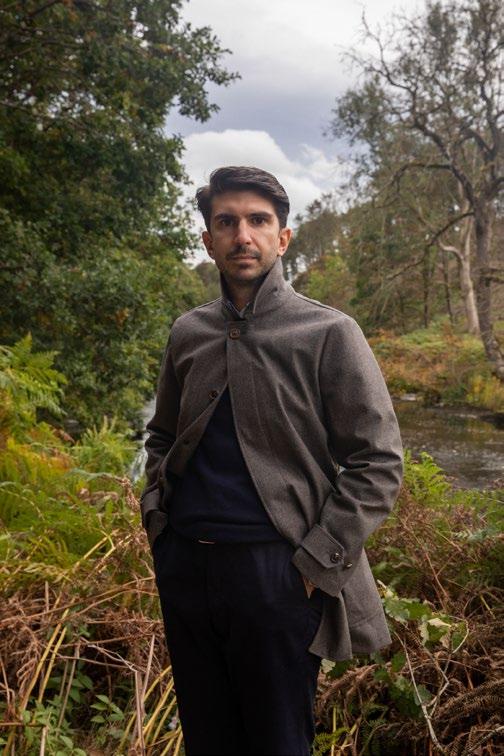
BEHIND THE BADGE DIADORA
JAI MCINTOSH
PHOTOGRAPHY CHRIS GERRARD
As part of our Italian Road Trip with Tessuti, we visited the headquarters of global sportswear brand Diadora, located in the quiet yet picturesque town of Caerano di San Marco.
During our visit, we sat down with the brand's CEO Enrico Moretti Polegato to discuss authenticity, sustainability and training the next artisanal generation.
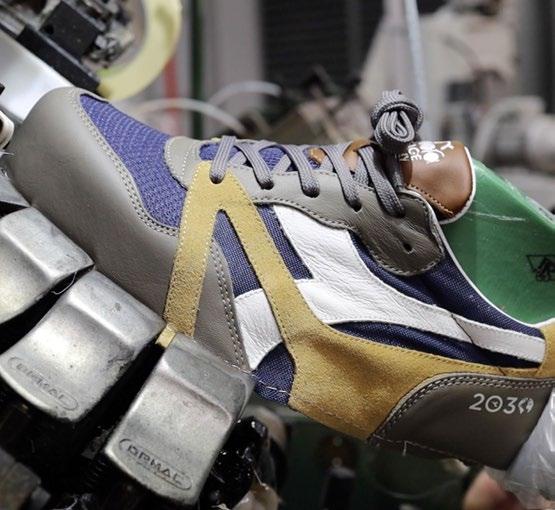
BEHIND THE BADGE
BEHIND THE BADGE
WORDS
35
For many, Diadora is a brand synonymous with Italian sporting excellence. Few could forget the electrifying footwork of Roberto Baggio, the expert racket skills of Björn Borg, or the track and field speed of Edwin Moses, all known for their relationship with the Italian footwear brand.
Despite this, Diadora’s global impact in sport and lifestyle fashion has waned slightly. Nonetheless, they have not dis appeared, on the contrary, they’re back to their very best. Under the leadership of Enrico Moretti Polegato, Diadora have placed sustainability at the heart of their project, aiming to elevate their product quality whilst reducing the carbon intensi ty of production.
JAI Diadora claims “We want to be by everyone’s side while taking every im portant step of their own path, and make sport our philosophy of life.” How does sport inform Diadora’s contemporary philosophy?

EMP Sport is the real basis of the Diadora philosophy because we were born as a sports company and we have been the symbol of Italian sports all over the world. We have a wide range of products, but every strategic and marketing decision comes from sport as well as every new style and every new technology.

"
36
We look at our collaboration with athletes in a different way, it is not a way to show off our product and logo. We work with them to test our products in extreme conditions and to improve the quality of the product through athlete feedback.
I guess that fashion gets more and more close to sports, maybe because we are looking for comfort, or looking for some thing more real, more authentic. That is the philosophy of Diadora; remaining authentic and loyal to our sports roots and sports models.
JAI Diadora has become famed for utilising Italian-made products in line with experts from various professional fields. Why has it always been important for Diadora to collaborate so closely with various athletes?

EMP We look at our collaboration with athletes in a different way, it is not a way to show off our product and logo. We work with them to test our products in extreme conditions and to improve the quality of the product through athlete feedback, giving our customers the best product. Our athlete CRD, the Diadora develop ment centre, is a matter of pride for us. In that, our design people, our research people, and our production people can work together to get the most up-to-date
products to the customer. We have some custom made machinery to test our products, and our research there covers a whole range of issues, biometric research, material research, allowing us to create tailor-made products.
JAI The present and future of Diadora is geared towards sustainability, with the brand opting for a gradual and method ological approach to sustainable design. Can you tell us what methods Diadora are working on/considering for improved sustainability over time?
EMP Sustainability is very important to us; you cannot start with an output, you have to start with the input. The first aim is to create an environment and a long-term project to have Diadora as a sustainable business. Our sustainability plans do not only involve our product, but our corpo rate affairs and our supply chain; a 360 approach.
JAI What is the significance of having higher-end products made in Italy?
EMP Made In Italy for Diadora is first of all a way for us to invest in our authenticity, in our brand. Being Italian is at the real core of the Diadora project. Through Made In Italy, we are investing in ourselves and we are also investing in our territory. Monte belluna district is one of the best places in the world to create and produce perfor mance shoes. We are the only company to produce real Made In Italy shoes here. We are perpetuating this knowhow through employing young people and teaching them artisanal techniques.
One of the main reasons that pushed me to take this challenge and buy the brand was the strong heritage the brand had. The authenticity and more than 75 years of the brand was really appealing. Having our products, our heritage, in the prime location across the world, is a matter of pride for me and is the ideal way to show the world what Diadora stands for.
Shop Diadora at tessuti.co.uk
37
" We look at our collaboration with athletes in a different way, it is not a way to show off our product and logo. We work with them to
CRUYFF: ON THE PITCH
Not only was he a genius, but a trailblaz er. He made small, yet highly influential changes from the very start of his career, such as donning a different number in his electric comeback against PSV. That aforementioned iconic 14 on his back as he assisted Ajax in winning 1–0.
The Grandfather of Football and So Much More
ootball is wonderful, isn’t it? An uncomplicated game that has developed its own nuances in culture and style both on and off the pitch. Now, I’m a man of simple pleasures in life, and watching 22 people kick a ball around a big rectangle of grass is right up there alongside good coffee and vinyl. But that simple nature of football has grown and matured since its inception, exploding exponentially over the past 50-odd years.
The growth of the modern games’ rise to its current heights can be encapsulated by one man who touched all corners of the pitch and beyond. Pep Guardiola, Jose Mourinho and so many more credit him with developing the blueprint of modern football. This man is Johan Cruyff: a three time Ballon d’Or winner in 1971, 1973 and 1974; the lynchpin of Rinus Michels’ Total Football system; the European Player of the century; and, at one point, the world’s most expensive player.
I’ve always found it criminal that I have to remind people about this spectacular Dutchman. Football conversation doesn’t spare time for him and his Netherland’s side and neither, actually, does pop culture chatter. A ridiculous feat considering the cultural impact of this team on the coun try, heralded as equivable to The Beatles’ turn for English music. Cruyff himself Lennon, with the accompanying number 14, orange jersey as iconic as those round glasses.
Now, I see you sitting there shrugging. “Why is this so important? Squad numbers are a thing, Louis,” and you’d be right. They are ‘now’. It hasn’t always been this way. In fact, when Cruyff was starting out, your starters were endowed with numbers 1 to 11. Cruyff donning the 14 made it his own, made him unique; and when he took Ajax to the top in 1972, gathering three Euro pean Cups under his belt, this individual number 14 became the best in the world.
Cruyff was also a man of principle. When the Ajax hierarchy, disagreeing with him, tried to sell him to Real Madrid for a world-record fee, Cruyff refused on the grounds that he “couldn’t join a club asso ciated with [dictator] Franco.”
Ultimately, he moved to Barcelona in a move valued at $2m in 1973 (around $13.4m today). It’s always these images of Cruyff that tickle the nostalgia in me, standing staring into the middle distance in the glorious, era-defining Meyba kit, with messy hair that perfectly encapsulates the 1970s. Freedom, art and expression had returned with Spanish democracy and Cruyff’s football became a power meta phor that instilled him in Catalan hearts.
And, of course then, at Barcelona, Cruyff played a pivotal role, dismantling Real Ma drid 5-0 at the Santiago Bernabéu, leading them to their first title in 14 years. A huge moment for the Catalan side, thousands of Barcelona fans poured onto the streets to join the huge celebrations, with one New York Times reporter claiming that “Cruyff had done more for the spirit of the Catalan people in 90 minutes than many politi cians in years of struggle,” garnering the nickname, "El Salvador.”
That year, as well, saw Cruyff and that Dutch side power through the 1974 World Cup, simply tearing teams apart right up until the final.
His self-confidence and artistic flair were there for the world to see in a group stage game, debuting that most famous of turns. Poetry in motion, one could say, a sim ple little twist of the body dumbfounded defenders. I often compare it to my Great Aunt’s cooking; sometimes, there’s an elegance in simplicity. The Cruyff Turn was born. Though the Dutch failed to surpass a West German side led by Frans Becken bauer, their stylistic qualities and poetic beauty have loomed large in the collective consciousness of footballing fans since.
After this tournament, Cruyff continued playing, until briefly retiring in 1978 before returning to play in the United States. He credits this time for his understanding of football business, sponsorship and mar keting. Shortly after, he returned to Spain with Levante, and then eventually the Netherlands with boyhood club Ajax. After a dispute with Ajax over a new contract, Cruyff joined their bitter rivals, Feyern hood, and worked, with an uncompro mising level of spite, to achieve them the silverware. An admirable pettiness, similar to myself when throwing my brother in a pond, aged 8, after he took the last of the Jaffacakes.
CRUYFF: OFF THE PITCH
But as much as he can be credited for some dazzling displays on the pitch, it can be argued that it was his actions off the green that laid the foundations for modern football.
In the 1985/86 season, Cruyff returned to Ajax as a manager, delivering success in the European Cup Winners Cup, though they may have, ultimately, lost to PSV, they racked up an impressive 120 goals. He also led Ajax to KNVB Cup victory that same season, and the following.
Ajax philosophy developed then, and the components of it spread across Europe. Players Cruyff managed, such as Rjikaard and Berkgamp took the DNA of Ajax’s new philosophy and coached their own teams to success. Some played in the ’95 Cham pions League Final employing his style, tactics, and formation.
Meanwhile, in Barcelona, President Josep Lluis Nunez sacked almost half the players
WORDS LOUIS BENEVENTI
38
and coach, coaxing Cruyff from Ajax to take over. Soon, his revolution of the team began.


‘El Salvador’ returned and led the club into a golden age, bringing in legendary players such as Ronald Koeman, Michael Laudrup, Romário, Gheorghe Hagi, and Hristo Stoichkov. These players formed the ‘Dream Team,’ where Cruyff quickly employed the style of free-flowing football that he, himself, embodied on the pitch and then encouraged at Ajax. This then went on to form the basis of Barcelona’s Tiki-taka style.
The Dream Team went on to win one Eu ropean Cup, four La Liga Championships (three of which were in a row), one Cup Winners' Cup, one Copa del Rey; and four Supercopa de España. Cruyff became the club’s longest serving manager and most decorated until his student and protege, Pep Guardiola surpassed him, who still credited him with the club’s success dur ing his tenure:
“Johan Cruyff painted the chapel. Barcelo na coaches since merely restore or improve it.”
After a trophiless two years at the end of his tenure though, Cruyff was relieved of his duties. He went on to take adviso ry roles at Ajax, and, unofficially, to the Barcelona President Joan Laporta. Cruy ff’s footballing influence remained, with Rijkaard and Guardiola leading his school of thought.


I still remember the day he passed away vividly.
My phone buzzed, the notification popped up, and my heart jumped into my mouth. It had only been a few days before that I’d sat with my dad at our usual post matchday haunt and he’d been telling me about the Dutchman’s impact on football. Now my old man gets very animated talking about history and football, and I under stand why with Johan Cruyff. His influence on the game is incomparable. A man of principle, fearless in the face of Franco, stylish, and an artisanal beauty playing football. The Grandfather of Football.
Bedankt, gracias, and thank you, Johan.
@louisbeneventi
39
Images courtesy of Meyba
FOOTBALL, AND PLAYING GUITAR
WORLD CUP, THE FUTURE OF SWISS
HIS HOPES FOR THE UP-COMING
THE SWISS NUMBER ONE GIVES US
ONE OF THE GREATESTGOALKEEPERS OF A GENERATION,
WORDS JAI MCINTOSH ONE OF THE GREATEST GOALKEEPERS OF A GENERATION, THE SWISS NUMBER ONE GIVES US HIS HOPES FOR THE UP-COMING WORLD CUP, THE FUTURE OF SWISS FOOTBALL, AND PLAYING GUITAR
WORDSJAI MCINTOSH
PHOTOGRAPHY FABIAN MICHEL SAMY EBNETER
PHOTOGRAPHY
40
FABIAN MICHEL SAMY EBNETER

41
BUT MY CONCENTRATION IS ON SWITZERLAND OUR TEAM.

THAT WE CAN ACHIEVE A LOT OF THINGS 42
I BELIEVE
CONCENTRATION
SWITZERLAND AND BELIEVE OF
ann Sommer occupies a fascinating half-space within contemporary Eu ropean football. On one hand, well, with both hands, Yann Sommer is still considered one of the very best goalkeepers in football, whilst on the other hand he has maintained his commitment to his club, maintaining distance from the money-laden grip of the Premier League.
Y
Despite a disorientating start that saw me slightly embarrass myself by not checking my junk folder and therefore missing the first interview, Yann kindly offered his time again. An opportunity that one could sim ply not pass up, I ensured I was awake and ready for our early conversation, perhaps waking up a little too early in anticipation.
That said, speaking to Yann was at once highly exciting and slightly surreal. Yann Sommer is, I am sure, a well-known figure amongst our footballing readership. Speaking to someone that you have known for years, albeit as a peripheral figure that appears in highlights and video games, is a unique experience, one that never bores. So, for fear of waxing lyrical for too long, here is my conversation with the Swiss legend, Yann Sommer.
JAI This World Cup is slightly different for almost everyone involved. That being said, how significant is this World Cup for the Swiss national team?
YS First of all, we are looking forward to this tournament, it is the biggest deal for any player to play at the World Cup, we have amazing support too. The preparation is
different, obviously. This is no problem for us as we believe we can adapt, we are all match fit, and we have worked as a team for long enough to utilise our eight or nine days in Qatar prior to the tournament to put a plan together.
We get to compete in a diverse and strong group, with Brazil, Cameroon, and Serbia which should be great. We have a high quality team, we will be planned and pre pared, and we will be ready to rise to this challenge. We have belief.
JAI Do you think this current Switzerland side can make it to the quarter final and potentially beyond that?
YS We are aiming to get to the quarter final, and we believe that we can. I am the guy who, at the start of the tournament, wants to focus on every single game and get out of the group. From there on, then we get to enjoy the ride. That is open, and that is uncertain. We need to focus on our group, getting results, and moving on to the next stage. For me, I choose not to focus on other nations, I am not thinking about who is the favourite. Of course, you have a lot of big countries with an ex ceptional history, but my concentration is on Switzerland and our team. I believe that we can achieve a lot of things, which means getting results in key games and performing our best in key moments. We can certainly do this.
JAI What are your hopes for the Swiss national team heading into the 2022 Qatar World Cup?

YS When you have a new coach, everything changes. In a national team, it is important to remain unified as a team. I have known some players for ten years, perhaps more. We are a good team, and for a new manager, it can be difficult, but we are a nice team and we are keen to get working. We have been welcoming and willing, and he has been excellent with us. We hope to bring some success.
You are now considered one of the
43
JAI
My concentration is on Switzerland and our team. I believe that we can achieve a lot of things.
greatest Swiss players to have played the game. A lot of this is due to your consist ently quality performances for the national team, (as well as at club level). How has your role in the team evolved throughout the years?
YS When I started out I was a young goal keeper, so inevitably I had a lot to learn. Now, with all of my experiences, I am able to help our excellent young players. For me, I pride myself on being a leader within the team and I hope my perfor mances show that. I want us to achieve as a team, and this means being prepared for the future.
We have some of the best young players in the world. We are full of quality in all positions, even in my position! We have a beautiful future, the young players work so hard in the team, and that stems from our youth footballing projects within Switzer land, and how we support young players outside of the domestic set-up. I hope to be involved for as long as possible, and I also hope to maintain my performance levels, I am a little older now (laughs).
JAI I have counted 24 penalty saves throughout your career, a highly im pressive number. Talk me through your process for saving penalties?
YS Of course we have a plan, but we do need a little bit of luck. I try to prepare be fore the game, I research who takes penal ties, I watch videos, read tactical analysis,
and I try to implement a fluid plan that changes depending on the player taking the kick. It is always like a roulette game, it is 50-50. You can prepare all you want, but you need those other variables to be on your side.
JAI As football has evolved, the need for goalkeepers to play with their feet has be come of central importance. How has this process impacted your game?
YS I was really lucky, I always had coaches who wanted a goalkeeper that was strong with their feet, so in training I have played in striker, central defence, everywhere!
This was normal from the age of nine, the coaches ensured we were strong with both feet. At Basel, when I was third choice, I would be playing across the midfield in training - I would have to try and defend against Xherdan Shaqiri, in training, which certainly taught me a lot about using my feet, although defending against him isn’t always that easy or fun (laughs).
JAI You have been a key player for Borussia Mönchengladbach since joining the club. How has the club evolved and in what ways has your club football positively impacted your national team football?
YS I am eight years into my career at Borussia Mönchengladbach, it is a long time. Since the beginning, it has always been a good choice. I came as a young keeper, with a bit of international experi ence. It was a new league, a massive club with a rich history, so I was a little nervous.
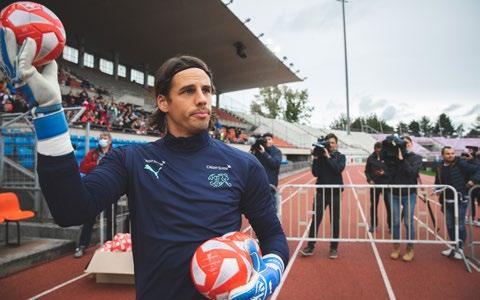
Saying that, it has always been a great place to work, surrounded by ambitious people, that is all I wanted.
It was a high-pressure move for me, Ter Stegen had just moved to Barcelona, which was an incredible move for him and demonstrated his level. I have always said since the start, I am not aiming to be ter Stegen, I do not compare myself with him, I have a different style, a different charac ter, and I believe people see that. Here, it is tough because of Bayern Munich and their dominance, Dortmund and Leipzig are also very strong. We love this challenge, and believe we can compete at the top level.
Personally, I have developed massively. I met my wife here, I have two beautiful young girls, everything has changed. I am 33 years old now, no longer 25. The life experience I have had here is incom parable. The club has always been there throughout my personal development, and they have consistently supported me. This applies with the national team also, they have always been supportive of me and my family.
JAI What is the most underrated aspect of Bundesliga football?
YS If you live in England, you have the Premier League and not much else, why would you? The Bundesliga is stylistically different, with a lot of technical players. Bayern winning is a little boring, but as
44
I choose not to focus on other nations...
I believe that we can achieve a lot of things, which means getting results in key games and performing our best in key moments. We can certainly do this.
I choose on I believe achieve which results and best We 45
focus nations... can things, getting games our moments. certainly
teams we are trying to change that. The quality here is very high, stadiums are full, they’re beautiful, and so is the football.
JAI So far, what is the moment in your football career that you will never forget?
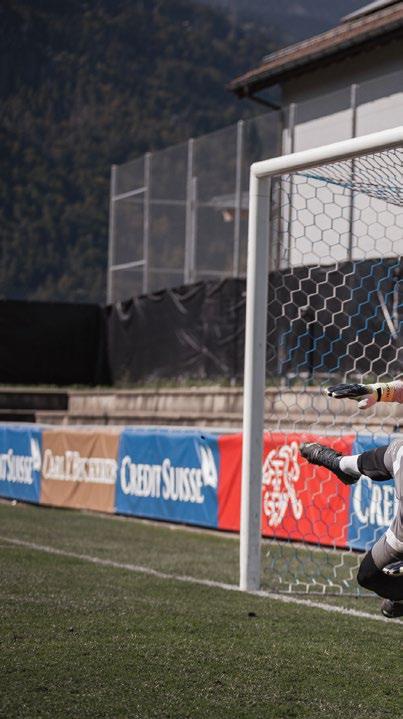
YS Ah, of course the European Champion ship with Switzerland because we arrived in the quarter finals after a difficult start in the group stage. I became a father during the tournament, it was wild. We then had a game against France, a game with a crazy history. We were down and out, but then we came back, and levelled the score at 3-3. Heading into the penalty shootout, I was confident and nervous, then I managed to save the Mbappe penalty. We deserved to win, we showed great charac ter and composer to see things through despite the slow start. An amazing day and tournament experience.
JAI As you mentioned, you’re a family man now. How is fatherhood treating you?
YS I enjoy it like crazy. For me, it is the most beautiful thing you can do - when you want them! (laughs). I try my best to be a good father, to give my girls as much love and support as I can. It is not always easy.
JAI What does down time look like for you?
YS Well, most of my time is spent with my family, which I really love. Apart from that, I love playing the guitar and singing. I have taken lessons in both and I am actually really passionate about it. I love my food, and I try my best to stay in contact with all of my friends from throughout my career and before. Essentially, I will do anything that keeps me away from football when it is time to relax, that time is vital.
JAI Should we be expecting a Yann Som mer album post retirement?
YS I don’t think so (laughs). In all seri ousness though, playing music for me is something really special. It also introduced me to people outside the world of football, they had different perspectives on life, and that is something I value highly. Inside football, it is football only. Moving out of those spaces at times is one of life’s beau tiful moments.
@ysommer1 46
THEN I SAVE THE MBAPPE

47
Heading into the penalty shoot-out, I was confident and nervous, then I managed to save the Mbappe penalty. We deserved to win, we showed great character and composer to see things through
Hak Baker’s music encapsulates city living; nostalgic memories meet London truths in his melodic G-folk sound. But Baker does more than just his art, he has his platform, Bricks In The Wall, designed to create a space for artists and musicians to be themselves, whilst remaining inclusive and accessible to their communities. Wax London sat down with Hak in his studio to talk about his musical process, his relationship with London and what he has coming up.
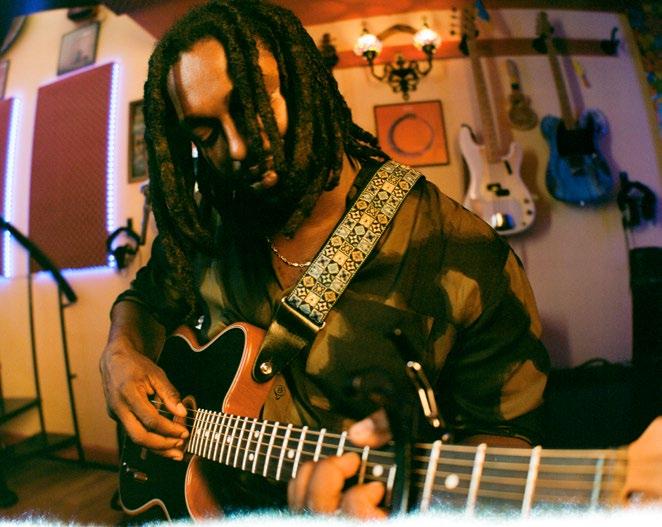
48
WORDS BY WAX LONDON
WAX How do you think growing up in Lon don and the Isle of Dogs has affected, or inspired, your music and process?
HB Yeah. Growing up on the Isle of Dogs and especially East London, there’s oppor tunity everywhere. You gotta have your ears open and move quickly, but that’s the first thing you learn or you get left. You re ally just have to know when to stand your ground, and when to go.
WAX So, when did you move out of the Isle of Dogs? Are you still living in East London? What's your favorite part about living in London?
HB I left my mum and dad’s when I was around 14 or 15, and moved in with Allie again. I've always been susceptible to love. I've always been open to love from a young age. So I fell in love with all the back streets of London from a young age. I was brought up on the street, basically, not in a bad way. I love the underworld though, but it doesn't really exist any more. Under world London was the best. It wasn't even horrible, it was just beautiful. People from everywhere coming together and having a good time. That doesn't really exist any more, it doesn't really feel like our London anymore. So yeah, falling out of love with it.
WAX How do you think those experiences shaped your style of music?
HB I think because there were a lot of different races all over and I didn’t know what I was doing. I was just taking a lot of music and inspiration from everywhere; school, reggae, garage and jungle, all kinds of stuff… you know what I mean? It was all a melting pot of different cultures and we, me and my mates, just brought all of that together.
WAX How would you describe that as a genre?
HB G-folk is like, just something that we've made accidentally. I just wanna tell stories about my life. I feel like our life's exciting enough to anecdote, you know what I mean? So then we just needed to make a bed where the lyrics could live. So hence the folk connotation, and then we had to like G up, you know, like, so that's why it's G-folk.
WAX Yeah makes sense. So, who would you say are your inspirations?
HB A guy called Terry Callier. He was this man from Detroit, in like the seventies or something, I listen to him a lot. My mate, Phil showed me him randomly when we were in Peckham one day and he just pulled out this vinyl. I felt like that was like new age folk, even then. So he was the man.
WAX So tell us a bit more about your mu sical journey. How did your sound evolve?
HB It's a long story. I just kind of got to an age where I felt like I needed to, I wanted to do something different. I always liked guitar. So when I got one, I had to teach myself how to play it. So I just used to just play things. I think I've got a good ear for that stuff. I would record it on my phone but I didn’t know how or where to start. The only person I knew was Allie, and I told him I wanted to make tunes and he said he would build a studio and he did! We came here, and we just made some tunes.
WAX Cast your mind back to when things were better and you did love London, where would you say was your favorite part of it?
HB My happiest memories of London are just being a bad man. Like 2005, 2007. That was the crazy Brick Lane era. When it first comes back, like 2008/2009 to, like, 2013, and you could go raving at any time of the day. That's when it was alive, now it's dead.
WAX Tell us about Bricks in the Wall. For the young initiator, explain what that is and how that came about.
HB Bricks in the Wall is something that I’m building. It’s a collective of people being ourselves to the maximum. I'm a black left-field singer and it's difficult, because we don't belong. We're not fitting into their boxes or how they want us to be. You know, that we're not the most easily sold thing for them. We're just doing what we want and they don't really wanna support that.
We've been working hard for the past five, six years, so we've got a stage where we can put people on and make sure that they're heard. We did our first one in Cam
Young Again – Hak Baker
Juno – Sam Akpro
Dancing Girl – Terry Callier
I Wanna Be Adored – The Stone Roses
Fade Into You – Mazzy Star
Turn Israel – G.T. Moore
Yam Yam – No Vacation
Closer – Mr Fingers
West End Girls – Pet Shop Boys
Dosed – Red Hot Chili Peppers
Stick & Move – Big Sad 1900, Uce Lee
Adversity – DVS
Bricks in the Wall – Hak Baker
den, which was amazing. We had Connie Constance who's doing amazing right now. Rachel Chin Kaiwa and Bill Kaine who's gonna be super. So, like, I just feel like it's a step in the right direction.
WAX Let's talk about fashion. How would you describe your personal style?
HB Depends where we're going. If we're going out with the lads and we've gotta dress up, we will go for loafers and nice trousers and a shirt or polo. I just like to be comfortable.
WAX You've created a playlist for Wax Radio. What inspired this?
HB The playlist was just inspired by free movement, and at the same time, relaxing music. It's a mix of a fast paced and relax ing kind of tune. You gotta be in like Soho, because you're getting ready to go out. So you're getting lively and then you just relax, and go to a nice little pub and go to a nice little shin. That's where you shake your shoulders.
1. 2. 3. 4. 5. 6. 7. 8. 9. 10. 11. 12. 13. WAX
X HAK BAKER @hakbaker waxlondon.com 49
RADIO
CAPITALISM,
CORRUPTION
AND CHAOS: THE PROBLEM WITH QATAR 2022
 WORDS BY ROB PRATLEY
WORDS BY ROB PRATLEY
50
Football is a sport for everyone. Regardless of nationality, creed, religion, race or identity, we should all be able to come together and enjoy the spectacle of the beautiful game. England’s Women’s Euros 2022 triumph was a fantastic example of the inclusivity, respect and unity that sport can provide.
Ironically, about six months later, the exact antithesis is going to occur with Qatar 2022. A first ever ‘Winter World Cup’. Let me preface this article by saying I am wholly for offering opportu nities to countries outside of the traditional European bubble to host these tournaments. South Africa 2010 for a number of reasons remains one of my favourite international tournaments. However, I do object to Qatar hosting the competition for a multi tude of reasons.
Firstly, it’s a slap in the face to other countries with the footballing heritage and infrastructure in place already. Almost everything for Qatar 2022 has been purpose-built purely for the tourna ment. A number of the structures are temporary and will have no lasting legacy, or long term strategy behind them. Brazil took a similar approach in 2014 and nearly a decade on, they face tough questions about what the tournament actually left in the country. A number of the stadiums are destitute, badly damaged or have completely fallen out of use. The Qatar Stars League seems un likely to continue to pack out the stadiums after the tournament to ensure they remain relevant and in the public eye. This is be fore even delving into the ethical construction questions around the tournament. Migrant workers have been shipped in to help with this grandiose venture and a number have paid with their lives. Although the exact numbers are unknown, it is extremely concerning that this issue is being swept under the rug so often.
Secondly, from a spectator point-of-view, there seems to be a lack of clarity over what will and won’t be acceptable in Qatar. FIFA have promised a fan guide to be released well in advance of the tournament detailing this. At the time of writing, no such docu ment has been released. I am not going to be blasé and say local customs should be ignored. However, when said local customs are extremely limiting towards the LGBTQ+ community, forbid public displays of affection, advise against large gatherings and exces sive noise, and also sanction the consumption of alcoholic bever ages… it begs the question of what sort of atmosphere they intend to generate at matches. There have been whispers of allocated ‘fanparks’ where this behaviour is acknowledged and accepted. However, these appear to be charged at a premium, and who can actually get access to them seems to be an exclusive clique.
Thirdly, as with any major tournament, local hospitality expects their slice of the pie. Hotels have been priced up to extraordinary levels. The average fan has no chance of affording them, especial ly if their team progresses through the tournament. Again, tem porary accommodation has been constructed, but at the time of writing, it is still a work in progress and not fit for human inhabitants.
Fourthly, you have to look at the way it has impacted the sport ing schedule. Fixtures have been crammed together at the start of the season and players are already looking overcooked. The ever-decreasing summer breaks due to lucrative friendlies and pointless international matches have exacerbated this further. More players are getting muscular injuries and becoming doubts for the tournament. On the flipside, some players are simply not performing for their clubs to their maximum potential right now, likely due to having one eye on playing for their country in November. As a result, it is producing some strange and skewed results across all tournaments. I am predicting a lull in the quality of games in November and January as a result.
Finally, I have to discuss the climate issue. It is going to be ex tremely hot inside stadiums, and regardless of any cooling meth ods, frequent water breaks will be required. Players will be pushed in climates they are not accustomed to, especially those coming from the start of a European winter. This is going to disrupt the flow of matches, but more to a point, it is going to be dangerous for players. These are elite sportspeople in peak condition giving their absolute maximum - the conditions have been inappropriate and extremely hot, humid weather is not suitable.
For these five reasons, it’s very hard to be excited about Qatar 2022. However it is being dressed up with the media, by FIFA and by local Government, this feels like a watershed moment. The first World Cup where the focus is less on what it brings to the fans, rather instead who can line their pockets the best.
Renuka Odedra is a Football Writer for Goal, as well as a contrib uting author of Football, She Wrote. In conversation with Renuka, her Qatar qualms surface immediately:
“I feel uncomfortable with the World Cup taking place in Qatar for multiple reasons. For one, this World Cup has been built on the shoulders of hundreds of migrant workers who have been working in allegedly poor working conditions and many of whom have lost their lives. A lot of people are now calling for compensation for the families but we’ve known about reports of migrant workers' safety being compromised for some time now.”
“The other side of the coin is the alleged human rights issues in the country, including women’s rights and the persecution of LGBTQ+ communities. For FIFA, an organisation that loves an equality PR campaign, they’ve really dropped the ball on this one by awarding one of the sports' most prestigious tournaments to Qatar.”
As Renuka goes on to explain, the issue can be perfectly encap sulated, “The big question is could and should FIFA have done something sooner?” An apt and seemingly simple question, but one not so easy to answer.
51
A deeper look into the legends & legacies behind Group B
WORDS
JAI MCINTOSH
As we tumble towards a World Cup, a World Cup that is seemingly just as questiona ble as the 2018 Russian World Cup, England fans are likely to be the least confident they have been for an international tournament in six years.
Qatar as a venue to host the World Cup Finals is clearly farcical, one need not de tail the litany of open-ended questions and qualms that surround the event (see page 50), these have been well covered and will continue to be covered. Additionally, one need not lament the overt greenwashing, with officials claiming this World Cup will be carbon neutral, despite a 2021 Fifa re port suggesting there will be 3.6m tonnes of carbon dioxide, 1.5m tonnes more than the Russian World Cup. Further, the air conditioned grass that requires 10,000 litres of desalinated water to maintain in winter and up to 50,000 litres of desal inated water in summer. As Fifa set out
ILLUSTRATIONS EMILY MENZIES 52
a carbon neutrality climate strategy by 2040, many have had reason to question how this coming Qatar World Cup fits into that plan?
Anyway, to the beautiful game.
As his popularity gradually waines, Gareth Southgate could be forgiven for feeling a little aggrieved considering the huge improvement the Three Lions have made under his tutelage. At the time of writ ing, Southgate has been in charge for 76 matches, winning 46 and losing 13, as well as helping England reach the World Cup semi-finals and the European Champion ships final. Thus, England are the nearly men of international football, a reputation that is increasingly breeding frustration amongst a relatively patient fanbase.
The Southgate debate centres predomi nantly around his tactical aesthetics and squad selection, both of which are deemed a little too conservative to galvanise and maximise the talent within the team. Per haps this is true, few could argue against the notion that England have enviable attacking depth, all capable of dazzling attacking displays; bums off seats football. However, international football tends to be a cagey affair, an occasion designed for the light-footed, and defensively sound. Both Johan Cruyff’s 1974 Dutch team and Socrates 1986 Brazil, whilst capturing the global imagination, failed to win the tournament irrespective of their attacking prowess.
Even the most ardent anti-Southgate fans will have to accept his presence on the touchline for this coming tournament, thus, speculation must shift from wheth er Southgate is justifying his position, to squad selections and tournament success criteria. England might not be outright favourites, with France, Brazil, and Argen tina all looming large. The Three Lions will be aware that, in keeping with their upward trajectory, the next step is to clasp both hands around that which is the most desired, the World Cup trophy. As mentioned previously, the talent is clearly there. England’s roster of attack ing talent, the most impressive aspect of England’s squad, is all but complemented by the exquisite midfield pool, with some of European football’s most exciting young players such as Mason Mount, Phil Foden, Jude Bellingham, and Declan Rice all likely to adorn the red and white colours of mighty blighty.
Defensively, questions arise, specifically relating to Southgates’ decision to bring every English right-back currently playing professional football. Reece James will miss the tournament, meaning space for Trent Alexander-Arnold may open up. The central defensive positions have historically been the weakest point of Southgate’s side. Despite hardly featuring for Manchester United, Harry Maguire is likely to go to the World Cup, and start, which seems nonsensical given the quality of other options. John Stones has been excellent this season; Fikayo Tomori is one of the most promising young central defenders in world football; Eric Dier may be a much-needed chaos agent, and then the rest is up for grabs. It is worth a men tion that, at the time of writing, the official squad is yet to be released.
This leads us perfectly onto considering the group. England are joined alongside Wales, Iran, and the United States in a roguish Group B, a group that looks more like a collection of nations found in a Daily Mail headline generator than a World Cup group. British counterparts Wales will be quietly confident, The United States will be looking to get one over on their football ing big-brothers, and Iran are likely to be as unpredictable as a box of frogs, with
many wondering whether the on-going social upheaval following the death of Mahsa Amini and the subsequent deaths that have followed in the wake of national protests will derail the Team Melli focus, understandable if so.
For all that is said about the England fanbase, both domestically and interna tionally, for their damaging behaviour and rampant xenophobia, it is worth mention ing that England fans are at once stoic and sentimental in equal measure. Whilst many demand trophies, many others are simply looking for a fulfilment of the cliché; they want the side to do us proud.
The UK, more specifically, the Prime Ministerial revolving door policy, has been a global embarrassment. Oftentimes in recent years, footballers have been left to shoulder social responsibilities often disregarded by elected officials looking to safeguard their seat rather than address social concerns. Once again, the Three Lions find themselves in the position as national representatives with the task of elevating the global perception of this once great nation.
That said, this team is capable of such a feat once again.
53
54
Iran remains an enigmatic footballing nation, one detached from the col lective consciousness of the Western nations that occupy the other spaces within their group. Iran has been a key subject within contemporary social discourse following the death of Mahsa Amini, and the subsequent social protests which have seen major sporting, political, and social figures both inside and outside of Iran cutting their hair off as a sign of solidarity with the on-going plight of the women-led protests.
For Iran, being in a group alongside both the United States and England evoked overwhelming feelings of opposition given the involvement of both nations in Iranian political affairs stretching back to 1953, with many Iranians still blaming both nations in the coup that overthrew the democratically elected Prime Minister, Mohammad Mosaddegh.
For a nation often so polarised, Team Melli have been seen as a positive representa tion of Iran on the national stage, often spearheaded by one of Asia’s greatest players, Ali Karimi.
Ali Karimi, sometimes referred to as the Asian Maradona, had an 18-year club career, winning eight major club trophies, including a Bundesliga Championship and German Cup double with Bayern Munich and an Asain Games Gold Medal. However, despite his trophy-laden success, it was Karimi’s ethereal technique, a dribbling style in the mould of Zidane, that cap tured the global imagination. Starting at boyhood club Fath FC, a club who trained in the street with plastic footballs, Karimi earned a move to Iranian giants Perseopils in the summer of 1998, winning a domestic double in 1999, and another league cham pionship in 2000.
Despite keen interest from various Euro pean clubs, Karimi opted to stay closer to home, joining UAE side Al-Ahli in the 2001/02 season, helping them win their first trophy, the President Cup, whilst also finishing top scorer in the league. These successes culminated in Karimi being awarded the Best Foreign Player Award almost two decades later in 2020, a clear indication of his outstanding ability, span ning generations.
It was Ali Karimi’s emergence in Europe that elevated his stardom to a global level, becoming the third Iranian to sign for German behemoths Bayern Munich in 2005, despite a few cautions from club scouts as to his fitness levels. During his time in Bavaria, Karimi won three domestic
trophies, as well as netting important goals in the December Der Klassiker in 2005, as well as in the Champions League, scoring on his debut against Rapid Vienna. Whilst his few years in Germany may have been fleeting, Karimi left a lasting impression on the European game.
Upon leaving Bayern, Karimi spent the next couple of years bouncing around clubs, initially joining the Qatar Sporting Club in 2007, then moving to Al-Sailiya for a fee just over £4 million. In 2008, Karimi agreed to re-join Persepolis, hitting the ground running, scoring a hattrick in a 4-3 loss to Esteghlal in the Tehran Derby. A strained relationship with various manage ment structures saw Karimi leave Perse polis for the second time, joining German side Schalke, winning a second German Cup despite hardly featuring for the side. Following this, Karimi returned to Perse polis for a third time, captaining the side throughout 2011 and 2012. Entering the twilight of his career, Ali Karimi moved to Tractor Sazi, helping the Iranian side on their journey to Hazfi Cup glory in 2013 before announcing his retirement ahead of the 2014 season. Arguably Iran’s great est player, Ali Karimi weaved a footballing legacy that, to this day, remains as promi nent as ever.
Internationally, Ali Karimi is potentially more significant and equally turbulent. A major figure in the Iranian national team, Karimi helped Team Melli achieve third place in the 2004 Asian Cup, scoring a hat-trick in a 4-3 win of South Korea, win ning the Asian Player of the Year award in the same year. Having played well in the 2002 World Cup, Karimi had a relatively poor 2006 World Cup campaign losing two games and not playing in their last group stage fixture.
In 2008, Karimi was banned from playing for the national team following comments made towards the Footballing Federation Islamic Republic of Iran (IRIFF), but was reinstated a month later. Clear foreshad owing of Karimi’s coming social influence. Despite retiring in 2009, Karimi played in the 2010 World Cup, wearing green wrist bands, showing solidarity for the Green Movement. Karimi then retired officially from international duties in 2013.
However, following his retirement, Ali Ka rimi has been a catalyst for social change and a voice for perceived revolutionary ideas within Iran, constantly battling state-controlled media outlets and govern ment figures, including Iranian Supreme Leader Ali Khamenei. Karimi has backed the protests in Abadan, taken the regime
to task over the IRGC’s downing of Ukraini an Airlines Flight 752, and been fervent on crushing financial problems experienced by many Iranians after recent food price hikes.
In November 2017, Karimi accused the Ira nian Football Federation (IFF) of financial corruption. Alongside a collection of oth ers, Karimi demanded that the federation’s president, Mehdi Taj, deputy Ali Kafashian and Secretary-General Mohammad Reza Saket publicly declare their salaries. The Federation responded by denying any forms of corruption. Karimi published pho tos on Telegram of the gift cards sponsors had sent to Mehdi Taj, exposing him.
In May 2020, it was revealed that Ali Kari mi was the main donor in post-flood recon struction efforts in Sistan and Baluchistan. In 2021, Karimi rejected an invitation from the Islamic Republic of Iran Broadcasting company (IRIB) to appear in a presiden tial candidates’ debate organised by the IFF, instead appearing on a talk show broadcast on the Filimo online network. Karimi asked for a 2.5 billion-toman fee for that appearance, which he made out to the charity Servants of Imam Ali Ibn Abi Talib to spend on medicine for deprived children in Iran.
Karimi has also donated thousands of tablets to various charities in an attempt to increase digital literacy throughout Iran, as well as consistently donating toys and money to various communities. Returning to the Iran of today, Ali Karimi, alongside fellow Iranian and Bayer Leverkusen star Sardar Azmound have been vocal leaders in support of protests against the treat ment of Sepideh Rashno, Mahsa Amini and Nika Shakarami.
Few expect Iran to qualify from such a tricky group, and that is understandable. England have one of the greatest interna tional squads currently playing the game, whilst both Wales and the United States have reemerged as major footballing na tions post-2016. However, with a recent vic tory over Uruguay and a draw with African Champions Senegal, Iran could rock the apple cart although this seems unlikely.
Given the social unrest that vibrates throughout veins of Iran at present, foot ball might not be top of their priority list. That said, the power of the game suggests that, if Iran can perform and entertain, there is a chance their national perception can shift. With the need for global support greater than ever, Iran’s World Cup could prove to be more pivotal than we would perhaps expect.
55
Wales have qualified for the World Cup for the first time since their famous 1958 appearance. For Wales, the journey back has been a turbulent one, one of false promises and missed opportunities. That said, following their outstanding perfor mance at Euro 2016, Wales have cemented their place as a highly competitive foot balling nation once again.
Few would argue against the fact that Gareth Bale has been the outstanding player for the Welsh national team over the last decade. Not only becoming the youngest ever scorer for The Dragons, he has become his country’s all time record goalscorer, netting 40 goals in 108 ap pearances whilst captaining the side to a European Championship semi-final.
Yet, thinking back to the team of 1958, and who their star player was, only one name surfaces, John Charles. An ethereal footballing figure, Charles, born Decem ber 27th 1931, is widely regarded as the greatest Welsh player of all time despite the Gareth Bale insurgency. A name not as celebrated as it should be, Charles revolutionised the British and Italian game throughout the 1950s and 1960s, with his most notable spells at Leeds United, Ju ventus, and Hereford Town. Eclectic.
His debut for Leeds set precedent for one of the greatest footballing careers of all time. Aged 17, Charles started in central defence against Queen of the South. Ten days prior to his debut, Queen of the South striker Billy Houliston demolished the England defence as Scotland beat the Three Lions 3-1. Charles prevented the attacker from scoring, with the game end ing 0-0 with Houliston claiming the young Charles to be “the best centre back I have ever faced.”
Returning to the club in 1952 following national service, Charles would go on to score 157 goals in 297 games. Strange for a centre back, but not for Charles who per formed to a world class level as a central
defender and attacker, further proof of his quality. Alongside his personal quality, it was under his captaincy that Leeds United were promoted to the English First Division where he scored a record 38 goals in 40 games as Leeds finished in eighth placethis was their first season in the division.
This earned the totemic Welshman a record-breaking £65,000 move to Italian giants Juventus in 1957. A route, even to this day, rarely taken by British players. This transfer allowed Charles to become one third of The Holy Trident, an on-field relationship between Charles, Enrique Sa vori, and Giampiero Boniperti. This allowed Charles and Juventus to win three Scudet tos and two Coppa Italias in five seasons. During his Juventus career, Charles would place third in the Ballon d’Or, score 108 goals in 155 matches, earn the nickname Il Gigante Buono (The Gentle Giant), and, in 1997, Charles was voted the greatest foreign player to have played for Juventus.
However, as an Englishman, it feels strange to be talking about a true Welsh legend without speaking to someone who really understands the true significance of John Charles. Fortunately, friend of EJ, Welsh BAFTA winning film producer and Talk Sport host Jonny Owen stepped up to give us his thoughts on the Welsh legend, the importance of the Welsh national team, and his hopes for the World Cup.
“We are all looking forward to it immense ly, qualifying for the first time in 64 for years is something special,” explains Jonny with an air of hopeful confidence. “These players are our golden genera tion, led by the great Gareth Bale who is arguably our greatest player alongside John Charles. We have a few key players in key positions, and the group has been relatively kind, we have to beat the United States and Iran. England I think are one of the tournament favourites, so we will see what happens there.”
As we moved onto the topic of John Charles, Jonny tilted his head slightly to wards the ceiling, remembering the stories
he was told as a young lad. “If you asked my late father who the best Welsh player of all time is, he would say John Charles without thinking. He is our Bobby Moore. Until Garteh Bale, there was never an ar gument as to who the best Welsh player was. Like Bale, he took Wales to a World Cup and won multiple trophies domes tically and abroad. The best way for me to describe John Charles is to leave it to Pele, who said the most important thing in Brazil’s World Cup victory was John Charles being injured.”
“His injury is one of the great what-ifs of Welsh football. We are a sentimental bunch, and we do believe if Charles had played, we could have won. He could play in any team of any generation, he was simply outstanding. In Italy, if they took the lead, they would move Charles from a striker to a central defender, just because he was so good at both ends. There was nothing he couldn’t do.”
When speaking about the current Wales side, Jonny stressed the importance of the group being more than just a foot ball team, “You cannot overemphasise how important this team is. I don't say this lightly, but they are up there with the great 1970s rugby team. They play on the world stage and represent us excellently. We are a nation of three mil lion people, the same as the midlands!” laughs Jonny.
"Look at what we have achieved with all of these limitations. Again, Gareth Bale, much like Gareth Edwards, is just known by his first name and he has given everything to making us as good as we can be. The football team represents the new, confident, modern, bi-lingual Wales. Welsh football culture is now more important than ever. Hopefully, the boys can do us proud and have a strong tournament.”
If the Red Dragons can harness the spir it of John Charles, and that legendary team of 1958, then there is little that can stop them. Now, we wait.
56
57
58
The land of the free, a place where you can achieve your dreams, well, potentially. The United States is often consid ered the leading nation, yet, in the world of football, or soccer as our transatlantic friends like to call it, the Unit ed States has historically fallen short.
That said, the Land of the Free has produced a smattering of solid football players who have adorned the kits of ma jor clubs both within the Premier League, and across Europe. Few fans of the prime Barclays era of the Premier League could forget the steadfast appearances of both Brad Friedel and Tim Howard, the slightly confusing whirlwind that is Brian McBride, and the original Captain America turned Lincoln City FC advisor Landon Donovan.
Yet, modern readers will at this point be thinking about the pool of youthful American players currently playing in the Premier League. Chelsea's Christian Pulisic is the pick of the bunch having won a collection of major trophies including the Champions League and Club World Cup, whilst Leeds United’s Brenden Aaronson and Tyler Adams have been pressured into diamonds this season; both key fig ures in aiding The Peacock’s campaign to remain another season in the league.
So too will readers be thinking about the evolution of American ownership in the Premier League, now a majority. Arsenal, Aston Villa, Chelsea, Crystal Palace, Ful ham, Leeds, Liverpool, Manchester United, and West Ham all have major American backing or majority American ownership. Chelsea’s new owner Todd Boehly has all but inflated the national perception of American ownership, with many Premier League fans sceptical of American own ership and the gradual leaning towards franchise models and greater marketing practices.
Aside from this, there was once an Amer ican in the Premier League who had a major impact, both for their quality, and for their personality. Of course, it could only be one man, Fulham's £4 million man, and the Premier League’s highest scoring
American, Clint Dempsey.
The Texan attacker is most famously re membered for his sparkling appearances in the Premier League, predominantly for Fulham and then for a brief spell at Totten ham Hotspur, with Dempsey claiming 100 goals and assists in 275 games for both English clubs in all competitions. Added to this, Clint Dempsey becomes the first American player in Premier League histo ry to score a league hat-trick, coming in a 5-2 Fulham victory over Newcastle.
The peak of his career, despite his 20 goal season in 2011/12, Dempsey was a part of that famous Roy Hodgson Fulham side that, amazingly, tip-toed their way into the Europa League Final in 2010. This game Fulham failed to win, losing 2-0 to the superior Atletico Madrid. That being said, what this represented for English clubs, and the central role Clint played, culminat ed in a memory that fans of the Premier League more generally remember fondly.
There may still be some judgement at tached to American players, especially in the UK, but it was clear from the start that Clint Dempsey would be a catalytic figure for the USMNT. Dempsey was awarded the 2004 MLS Rookie of the Year, an award that got him few plaudits across the pond, but for the national team, this was a key part of his player development.
Known fondly by his national teammates as Deuce, the former Fulham man be came the first American to score at three different World Cups, in 2006, 2010, and 2014. The year following the 2010 South Africa World Cup, Deuce stepped up for the USMNT once again, this time being the only goalscorer for his side against Panama in the Gold Cup, a tournament his side failed to win that time, but he did win it on three separate occasions, 2005, 2007, and 2017 as well as being the Top Scorer in the competition in 2015. Additionally, in 2007, 2011, and 2012, Clint Dempsey was awarded with the USMNT Footballer of the Year Award, indicative of the Clint cocktail of quality and longevity.
It is his international quality that separates
him from the rest, despite his Premier League performances being far better than many expected. Now, the USMNT are in a far better condition that they have been at any point before, no longer relying on a single star player despite Pulisic’s influence, and working cohesively, leading many to ponder the chances of the United States winning a mens World Cup before England get another.
Speaking to American broadcaster and football expert Elizabeth Helenek, it is clear that the young talent that occupies the majority of the USMNT is their main hope: “The USMNT is full of young talent who are playing for top teams in Europe’s top five leagues like Champions League winner Christian Pulisic, Leeds’ Brenden Aaranson, Juventus’ Weston McKennie and Dortmund’s Gio Reyna,” explains Elizabeth. “However despite the potential this team has, they have been struggling against other World Cup qualified sides, having lost 2-0 to Japan and tied 0-0 to Saudi Arabia in the latest friendlies. Additionally the US have faced 7/32 World Cup qualified sides, but only beaten one of them, a 3-0 win over Morocco, a cause for concern.”
After the friendlies, USMNT coach Gregg Berhalter said, "There's not many players that performed up to their normal levels in this camp, and that's just how it is.” For Elizabeth, things need to improve, “it will be vital for him [Berhalter] to figure out how to get this team to click and perform with the talent it has, in order to get out of a tough group of Wales, Iran, and Eng land. We are confident, but plenty of work needs to be done for us to qualify from the groups.”
There is now a slight sense of pressure on the United States to perform, perhaps not helped much by their totemic women’s team, who at most points seem unbeata ble. That said, from Clint Dempsey to now, the Premier League is incredibly the home of choice for various American players. Whether these young players are ready to compete at the highest level on the international stage is to be seen. They just might be a dark horse…
59
Friar has been working as
Newcastle United for seven years, first with the academy and now with the first team. As Newcastle skyrocket up the Premier League table, we thought we would catch up with Joe to talk about all things analytics.
JAI Firstly, could you describe your cur rent role at Newcastle United and what that role entails, please?

JF I am a Training Analyst at Newcastle. This involves being out on the pitch every day, filming the sessions, often with two drones. We film at the angles that the coach needs, this means we tend to work on specific players. We then go through the footage, clip certain bits out, and use them as we create session plans, all with video examples, to help them improve their quality in training which, we hope, improves their on-pitch quality too.
We now have a screen on the side of the pitch in training, so we can replay ma jor moments and recreate very specific scenarios. It's really interesting. I was a part of the analytics team at the Newcastle Academy and worked my way through. Things in the academy are different, you have to do everything from data, training, matches, opposition work. Whereas now, coming into the first team, we have multi ple people completing different roles, and everyone has a sole responsibility. Being able to specialise in the first team has been really helpful.
We do a lot of collaborative work. We are lucky enough to have a data analyst, who we work with on a personalised player data sheet for each player per match, these stats are then compared with all the players in the league in that certain position. We are service providers to the coach, we provide the data and make suggestions but ultimately the coach makes the decision on what we do with that information.
JAI As a club, how central is performance analysis at Newcastle?
JF When Eddie Howe joined, there were three first team analysts. We have now doubled in size plus gained another ana lyst working between our department and the coaches. The demands the coaches have on our department is really big, but ultimately that is a good thing. Out of all the coaches I have worked with, Eddie Howe and his team are the most interest ed in working with and using data.
JAI How have players adapted to analytics?
JF Players coming through the acade mies now have been brought up with data.
Academies have been using data for well over a decade, therefore this plays a large part in the way players view themselves and measure themselves. Additionally, the way we live now, people are exposed to basic data statistics every single day, and this then piques interest amongst players. We often do get asked by players for more information, which is always great to see.
It is important to tailor the analysis and data to the players. At the academy, we would tend to increase the level of data that the players were exposed to as they moved up through the different age groups. This provided a gradual increase to prepare them for what may be coming next. By the time they reach the older age groups, they are very comfortable with analysis and reviewing their own perfor mance using data. This ultimately pre pares them for a first team environment, when there is real vast amount of data available for clubs to use.
Technical data in training still has a way to go, we are at the start of this process still. I occasionally have to record data manu ally, simple data points such as shots, de fensive actions, etc. However, the problem
WORDS JAI MCINTOSH WORDS JAI
60
Joe
an analyst at
MCINTOSH
with elevating this side of data analysis is that most clubs won’t want their data and footage to be seen outside of the club, so we have to do a fair amount in house.
With the national team, the FA has their own analysts who are collating the same information as us. We have examples of national teams sending clips and match data to us, and we have sent data to them, it has worked both ways. Typically, I see the sports science departments asking for a lot of data before international matches, mainly health records and fitness numbers.
JAI How important will data & analytics be during the upcoming World Cup?
JF I think data & analytics will be very important and play a huge part. I would imagine every team will have multiple ana lysts as part of their backroom staff during the tournament, focusing their analysis on both themselves and the opposition teams that they may be facing. This will
also be the World Cup where more data and information than ever before will be available to the teams for them to use to their benefit, and also for the public via the broadcasters, apps and social media.
In terms of England, the FA are often at the forefront of leading change in football. They have been ensuring the use of data
is central to the England project. Hopefully England can progress through their group with such a talented team, in all honesty, if they can get out of the group anything can happen. Building momentum is key. England's style of play has been effective in tournaments before. I am cautiously optimistic and excited for what this team can achieve off the back of Euro 2020.
JAI What are the main objectives for the analytics department at Newcastle for the rest of the season and for future seasons?
JF We are just trying to develop consist ency. We have all of the roles filled, and all bases covered, we now want to work together to ensure we always provide a world-class service for the coach and for the club. We want to be the best depart ment in the league, which is in-line with the demands from the ownership struc ture; Newcastle are looking at being the best across the board, and we aim to help the club along that journey.
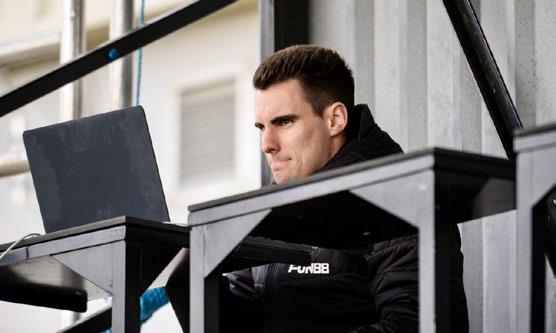
Out of all the coaches I have worked with, Eddie Howe and his team are the most interested in working with and using data. "
Out of all the coaches I have worked with, Eddie Howe and his team are the 61
"
DAVID M. ROBINSON
IWC X TOP GUN ROADSHOW
IWC Shaffhausen »
Big Pilot's Watch 43 Top Gun Ref. IW329801
WORDS JAI MCINTOSH

PHOTOGRAPHY THOMAS SUMNER
2022 has been the year of IWC Top Gun. We have seen the launch of several new models with striking colours and innova tive materials. In addition to launching “Lake Tahoe” and “Woodland” editions in statement-making shades of white and green ceramic, IWC also added a Pilot’s Watch Chronograph 41 Top Gun in Cer atanium® “Jet Black” and the Big Pilot’s Watch 43 Top Gun in black ceramic. Each new timepiece reflects the same hallmark performance and polish of the IWC Top Gun since the Pilot’s Watch Double Chron ograph Top Gun was introduced in 2007.
Following the success of last year’s The Big Pilot Roadshow, the touring exhibi tion began in Edinburgh this June before travelling to London, and then closing out in Manchester this October. The expanded time frame allowed those interested to engage more directly with the brand and afforded greater room to showcase the array of outstanding timepieces within this collection.
Ahead of the event, Grant Wilson, IWC UK Brand Director explained: “After last year’s success, we look forward to bringing the IWC Top Gun Roadshow to key UK cities. With IWC’s strong history of technological advances and innovative materials, we look forward to welcoming watch enthusi asts and the next generation to join us.”
However, at EJ, we also wanted to hear what those at the heart of the event had to say. Craig Jones, IWC expert for David M Robinson Manchester, spoke to us to give us his thoughts following the end of this year’s IWC Top Gun Roadshow:

62
JAI Firstly, how has the roadshow been?
CJ The Top Gun Roadshow has been a re markable success and brought even more visibility to the IWC brand. Last year’s roadshow events were fantastic; this year saw more footfall and reached a wider audience for sure.
Key factors in this success being the location choices and organisational skill from IWC to bring a unique aesthetic both from the shipping container design and hit Hollywood film, this generates an even greater brand recognition.
JAI What has the reaction been to the IWC x Top Gun collaboration?

CJ I would say the IWC and Top Gun collaboration has been hugely influential for reaching a larger consumer demo graphic. The International Watch Company has a longstanding history with Air Forces around the world since the late 1940's. IWC originally produced the Pilot’s Mark 11 for the Royal Air Force in 1948. The first Top Gun reference launched in 2007 and the partnership came into fruition.
To have this historical, aeronautical prov enance definitely appeals to an individual
looking for a professional, accurate, func tional tool watch.
JAI Do you think the success of Top Gun: Maverick as a film has helped the road show?
CJ The success of the Maverick film has most certainly helped the Top Gun Roadshow, the postponed release date had everyone eager to watch the film. Of course, the fact it is a superb film massive ly benefits the collaboration as well.
The product placement for IWC was dis creet and understated, fans of the brand can take pleasure in spotting the specific watch references shown throughout the film. The unique IWC Top Gun stopwatch headlined, taking centre stage upon the screen for a moment in a pivotal dramatic scene.
JAI Colour plays a central role in the IWC Top Gun collection. Can you tell me about the use of colour and why it is important?
CJ Colour is very much key to the design brief for Top Gun watches from the orig inal “Jet Black” references, to the newly released “Lake Tahoe” white ceramic and “Woodland” green ceramic watches, to the
unmistakable “Mojave Desert” editions in their incomparable, sand-coloured ceram ic case.
IWC and the collaboration with the inim itable colour palette specialists Pantone hit the headlines at Geneva’s Watches and Wonders Exhibition in March of this year. The colours selected by IWC have high lighted the fascinating training landscapes of the Top Gun Pilot’s themselves and have been made into a reality by Pantone’s expertise in the language of colour.
JAI Retrospectively, how are DMR and IWC feeling after the event?
CJ Finally, the mood is excellent. After the final roadshow, we felt it was an enormous success once again. Speaking personal ly from DMR’s perspective, it has again brought new customers to the IWC brand and cemented enthusiasm amongst exist ing clientele. Here's to many more in the future!

Find out more about IWC and further ranges at davidmrobinson.co.uk

63







NEIGHBOURHOODCOFFEE.CO.UK 15% OFF ALL COFFEE WITH THE CODE: EJ15 64
This issue's maker is Sumuyya Khader; a multidisciplinary artist who has combined her skills in illustration, painting, and print works to explore ideas surrounding identity and experience. Sumuyya is seen as a key figure in Liverpool’s artistic scene; firstly for her quality, and secondly, for her willingness to speak out about the treatment of artists, and particularly artists of colour within Liverpool. We met up with Sumuyya in her studio located in Liverpool’s Bluecoat, deep in her flow state, we abruptly arrived and nestled into the corner to ask a few questions...
PHOTOGRAPHY
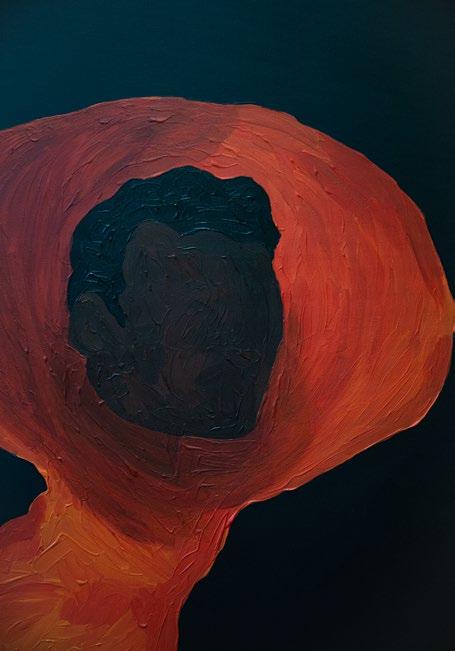
JAI MCINTOSH
BETH BENNETT PHOTOGRAPHY BETH BENNETT 65
WORDS JAI MCINTOSH
JAI As a self described ‘busy-body’, could you tell us all of the work that you do and how you started your creative career?

SK I am an artist, creative, and an illustra tor. I do a lot of book covers, posters, all of that good stuff. I am also a painter, some thing I have picked up once again over the last year and a half, and have run a few shows. I am involved in various projects with the Granby Workshop, and ultimately, I am most passionate about black crea tives in Liverpool, across the board, from visual artists to musicians, from writers to performers.
I have always been into art, my mum would put my paintings on the washing
line, it was always encouraged. Everyone is creative in the family. I went to uni, dropped out, and then went back in my twenties to study Fine Art. Working and studying was a challenge, which made me feel disconnected from the art scene, but since graduating, I have tried to become more involved. I'd say from 2019/20 I have ramped it up a lot.

JAI How are you able to manage life as a professional artist?
SK Honestly, I don’t know if I will ever be able to do art full-time, which makes me a little sad, but I am in a fortunate position. I work a part-time job, and spend the rest of my time creating, that is what I am used to.
I love filling time, but I can’t work properly while in the confines of a normal job, I need the escape of the studio.
JAI Who are your inspirations?
SK I have always been a big music head, but I can’t play music for shit (laughs). I just like listening to music. I can’t singcan’t do any of that - but I will have a good time. The best type of music for creating is jazz music, the rhythmic nature of it really helps. In terms of current artists, the Black-British scene is really cool right now. I did mention recently that the problem with it is that the scene is still very Lon don-centric, but it has been outstanding for the last five years at least.
66
I am inspired by sneakers, always have been. I am now a New Balance head (laughs), once you get a pair you realise the hype, and then you end up getting more. Oh, actually, Nina Chanel Abney is amazing, she inspires me a lot. She's leading the way.
JAI Your popularity increased during the height of the global BLM movement. How have you been able to express strength and solidarity messaging in your art?
SK Well firstly, at uni I think I was the only person of colour on my course, and it made me feel afraid. I think it becomes dif ficult to be critiqued on a subject that is so entwined with a sense of self, by peers who look nothing like you and have no idea of your lived experience. It wasn’t until I grew a little older that I developed greater confi dence and could express art more in the way that I wanted to see, reflecting faces that I wanted to see.
Liverpool becoming aware of its lack of black creatives has both greatly benefit ted me but also annoyed me. At the height of the movement they wanted to show support but now they are not there, which is fine, it's just a bit depressing. I tried to capture the strength of black women, I wanted to show some recognition of their plight and journey.

We are a small part of society, in terms of Liverpool and the UK, but if you look globally, there are a lot of black people out there. It is not my job to educate people, but I am happy to have an open conversation. There are plenty of resources for people. My work is for me, and people who look like me mainly, I want to represent us.
JAI What facet of your artistic qualities are you most proud of and what do you want to work on?
SK I am most proud that I can sustain a career in art, even though it is tough. For me, things like the Ben Okri book covers were a huge moment. It was the first cover I ever did, and it was really beautiful to work with a British Nigerian author, myself being of British Nigerian heritage - it won the Booker Prize!
I do sometimes have to remind myself that I have done some cool things, being creative is so frustrating at times it is easy to ignore the best parts. I have been part of various campaigns, I have had art displayed and sold, I have supported other creatives within the city, things are not all bad.
I guess for anyone who creates or is cre ative, or for people like me that are a little loud-mouthed. I want to start conversa tions about being a black creative living in Liverpool. I want to get rid of artists having to work and live within this hustle culture.
I would like to develop my painting skills, I love it. My show at The Bluecoat last year was a challenge for me to get my painting to a level where it could be displayed. I have a lot to learn, and I am at the begin ning of the process.
JAI What is your opinion on the ways in which artists are supported in Liverpool?
SK Some of it depends on the type of artist. I am not part of a studio collective, when you are a part of one, you have greater opportunity to collaborate nation wide. Working independently, things are
more challenging, which at points stunts growth. I hope the way in which artists interact in Liverpool gets better over the next few years. I would love to see and be a part of collaborative projects, and people should be paid better for these. Liverpool has dropped in terms of galleries and institutional quality - the artistic talent is here, but the opportunities and access to spaces have disappeared a little bit.
JAI What is your understanding of the per ception of being a Liverpudlian artist?
SK Liverpool has become a beautiful tour ist city, and it was the Capital of Culture, but not anymore. I feel like the city has been trying to reduce creative culture, and I am not even sure if it is intentional, I think it is poor management and under-funding. Young creatives leave this city for Lon don, which is bound to happen, but if we improve what we have, we could keep our creatives which is vital to the city.
For people, the city is still enigmatic and slightly removed, but there is so much quality here I am trying to be a part of the process that pushes this into a national conversation. Liverpool gets a bad rep because it is a working-class city, and it is not a shy city. The media has not always been a fan of us. We are the independents, but we want to collaborate and work with as many people as we can.
JAI How does your work make you feel?
SK I feel proud. I am able to express my self as best I can at this stage, and people have been supportive overall. There is plenty of work to do, and a long way to go, but I am happy.
@sumuyya 67
STEPPING OUT WITH ANDY ELLIS
ITV’s explosive new five-part thrill er dropped on our boxes last month, and the aftershocks are still coursing through. From the pen of the outrageous Jeff Pope and the keen direction of Paul Andrew Williams, Stephen Graham re unites with fellow ‘This Is England’ alum Andrew Ellis to investigate the covert goings on of far-right terrorist organisa tion ‘National Action’ as the group plots disruption on the highest level.
Each episode mounts tensions with a precision only few can master, excavat ing the very true events that occurred only several years ago with the trusted dramatic flair we come to expect from these kinds of prestigious ITV dramas. The series is dangerous, it’s risky, it
doesn’t fictionalise nearly as much as it probably should, instead adopting the brutal and honest truth; something, I’d be remiss not to say, this country fucking needs.
Catching up with Andy Ellis, it’s clear that, with a career that started tackling much similar issues on screen, he shares a similar perspective of the importance of modern media to push these boundaries.
“I think it’s probably easier for people to watch This Is England with a learned view, like, 'Oh, look how bad it used to be.' But I don’t think people are willing to admit how terrible the times we are currently living in are. The country is probably more divided than it ever has been at the moment, peo
ple are struggling and it's difficult. I think The Walk-In is brave in showing these recent tragedies and highlighting the state of the country for what it is now.”
“The real life elements of the show are tough to watch, especially for people who may have been affected by them. I'm so far removed from [his character] Robbie and his views but there are people out there who share them, even just minutely, in some way.”
And it’s interesting, isn’t it? How peo ple have consumed this show and been shocked about it? The far-right extremist group in the show is founded in the very same group that were behind the assassi nation of Jo Cox, a truth of Modern British
 BETH BENNETT
BETH BENNETT
WORDS
BY
WORDS BY BETH BENNETT
68
Stills courtesy of the ITV Press Office.
The country is now more divided than ever and the media always needs to point a finger, for me it’s never pointed at the actual causes of the problems but at easy targets that people can get angry over.
Society that needed to be exorcised but brought with it it’s own complications. ITV couldn’t do press for the show until one month before its release and, despite the massive feat of it, restricted spread on social media to ensure the safety of all those involved in the production. After all, pockets of this organisation remain.
Andy says: “ITV have been amazing on this and have really done their due diligence to protect us. With this type of thing there is always the concern of retaliation, but it’s something that needs to be brought to light. The country is now more divided than ever and the media always needs to point a finger. For me, it’s never pointed at the actual causes of the problems but at easy targets that people can get angry over.”
Going deeper into his character, Robbie, who grows involved in the organisation and becomes surrounded by extremist ide ology of the vibrant and angry young men, Andy, who hails from the small town of Wythenshawe in South Manchester, felt he had something of a duty to explore the reasons why so many work ing-class men end up in these types of groups in an attempt to help prevent such downfall moving forward.
land’ whilst still in high school and him, along with a plucky group of young actors, were guided by Meadows and the effer vescent Stephen Graham to create, what’s regarded by most, as The Best British Film.
“I’d say it was probably the most form ative time of my life. I was always pretty old-headed as a kid and adapted to the world of “work” really quickly. It opened up doors in the film and TV industry that are near impossible for people where I’m from. I knew I wanted to be an actor, but coming from a working class background I didn’t know what a drama school was and didn’t really know how to get ‘in’. I see This Is
"
much energy. Ste would take a moment before each take, I’d watch as he would go to a corner of the set, have a moment, and then transform. I nicked that and have used that method myself throughout the years. I’ll always be thankful to him and his lovely wife Hannah for all they have done for me.”
On where he’s going next, I, of course, have to ask if he would be game for the much mythic ‘This Is England ‘00’ series (a fourth instalment of Channel 4’s mini series following the film). Andy, with a grin, remarks:
The country is now more divided than ever and the media always needs to point a finger. For me, it’s never pointed at the actual causes of the problems but at easy targets that people can get angry over.
“If Shane called me up to help decorate his spare bedroom I'd be there! I owe the man so much. I’ve heard whispers and rumours (Shane mentioned it on mine and Thomas Turgoose’s Podcast during Covid) so I’d say watch this space. I think there’s room for another story from these characters, it’s been a while since we did ’90 and I’d love to see what Gadget’s doing for the millennium.”
“My first thoughts reading the script was that I knew blokes like this; blokes with low prospects and not much going on who could easily be led the wrong way by people with bad intentions. I'm from a town similar to Robbie where there is high unemployment and a general sense of abandonment so I related to that aspect of him. Thankfully I found my passion early on but for a lot of young blokes it can be bleak out there.”
His passion, of course, is in filmmaking. Andy landed the role of Gadget in Shane Meadows’ highly acclaimed ‘This Is Eng
England as my “training” in a way because it was such a full on job; but Shane works so uniquely that it really pushes you as an actor to consider your character in a unique way.”
Andy learned from Stephen Graham too, which is why this reunion feels like a full-circle moment.
“Being on set with Ste is like going to bloody Disney World. Everyday is a chance to learn from someone who has mastered the craft in ways people like myself can only dream of. I remember being 15 on the set of ‘This Is England’, watching and learn ing. Myself and the rest of the cast were loud, probably obnoxious, kids with far too
Until then, however, Andy is lending his voice to children’s animations, podcasting, running a production company (Odd Drawer Digital), being a wonderful husband and dad, and hoping one day he’ll finally get to be in the world of Game of Thrones.
In a final question before he returns to his exciting upcoming projects, I ask Andy what his favourite show at the moment is. I should expect it, really, when he answers:
“House of the Dragon. Paddy [Considine] is another fellow student of the Shane Mead ows Academy and it’s brilliant to see him in something like that and he’s smashed it.”
Catch Andy at @andy_lp_ellis Watch Season 1 of The Walk-In on the ITV Hub now.
"
The country is now more divided than ever and the me-
69
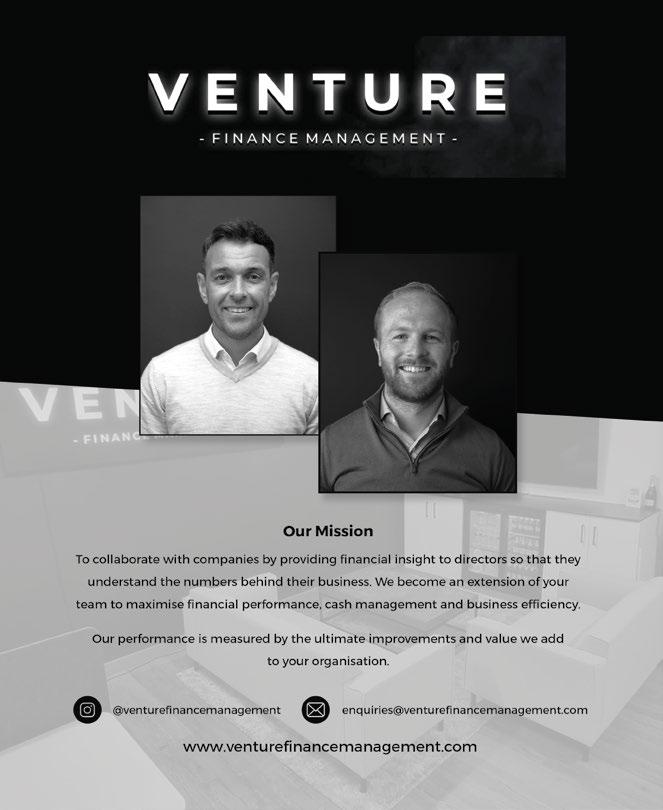
70
BOKINNI
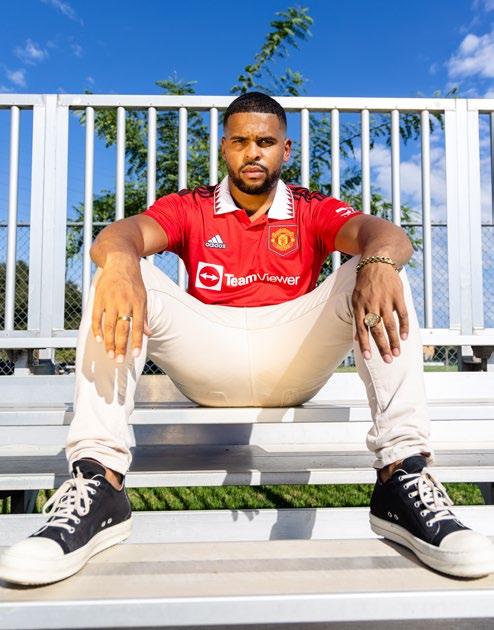
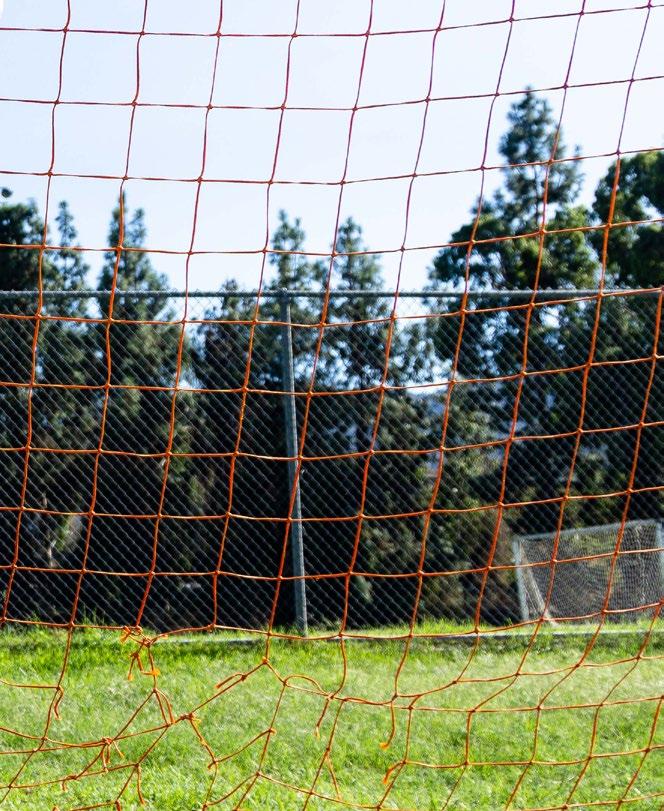 WORDS BETH BENNETT PHOTOGRAPHY HAYDEN BLAZ
WORDS BETH BENNETT PHOTOGRAPHY HAYDEN BLAZ
KOLA
KOLA BOKINNI A GREYHOUND BARKS:
71
of Apple’s hit cultural phenomenon, Ted Lasso, AFC Richmond’s most charming greyhound, Kola Bokinni (Isaac McAdoo), joined us for a chat about taking risks, footballing on screen, and the lasting legacy of ‘Believe’.

BB So firstly, I have to say, my editor is a huge fan of Top Boy and wanted me to tell you that he absolutely loved you as Leyton.
KB Thank you. Thank you, man. Appreciate it.
BB Now, Ted Lasso... That’s a completely different London, it’s a completely different world. What drew you to seeking out that change?
KB I wanted something different. It’s quite easy to get pigeonholed and get kind of typecast, especially when you're from Lon don. South London, more so. Top Boy was an amazing role, but after doing it for seven months, I was really keen to do something completely different. Then Ted Lasso came up.
I didn’t really know what it was. I was kind of sceptical of it — I’d seen some football shows that hadn't quite hit. But after speaking to my family who told me to take a leap of faith, I went for it. Now here I am, three seasons in.
BB You've got the likes of Brett Goldstein on the writing staff, but the series is mostly helmed by Americans. Was there ever a part of you that was worried about how they would take British football and footballing culture and potentially parody it?
KB I did actually watch that original skit, years ago now, the Hotspur skit. Over here we take football very seriously and in Amer ica they don’t. It's like if we tried to make a show about basketball and the NFL, really risky. But what they've managed to do is incredible. Looking back on the original skit now, I believe that 'Ted' is a very different character; yeah, they have the same name, they look the same, but this show isn’t like that sketch at all. It gets it. It gets British football.
Fresh from the set of the upcoming third season of Apple’s hit cultural phenomenon, Ted Lasso, AFC Richmond’s most charming greyhound, Kola Bokinni (Isaac McAdoo), joined us for a chat about taking risks, footballing on screen, and the lasting legacy of ‘Believe’.
BB Ted Lasso has a great gift of under standing the nuances of us all, yet it doesn’t linger in drudgery but rather finds ways to celebrate overcoming hardship and the joys of teamwork whatever kind it may be; have any of the shows themes seeped into your personal outlook?
KB Any role that you play, especially in TV which is long running, you’re always going to take a bit of that character with you.
I’ve become a little bit more compassionate,
72
just a little more patient. I've learnt to kind of step back and kind of look at the bigger picture.
And all the wonderful people I've worked with on this have softened me up too.
BB The reception was phenomenal as well, I mean, there must have been a big shift going into Season 2 following that success.
KB Yeah, there was. One of the producers, Chip, he says Season One was for the true believers because we didn't have a clue. There was no hype, there were no awards, or fans, or anything like that. Just us and our belief in the show.
BB And now you're in FIFA 23.
KB That is still something I don’t think I’ll ever get over. But it’s the magic of what this show has done. You know, it's crossed a lot of barriers. People will remember us for doing something new and I like that.
BB So, this issue of EJ is loosely World Cup related, we’ve got the Swiss National Team Captain on the cover.
KB The goalkeeper, yeah? Yann Sommer, I think he’s wicked.
BB He is! He really is. But, I have to ask, how do you think it’s going to be for Eng land?
KB To be honest, I just want it to be an exciting World Cup. I want it to be like… Remember when Greece won the Euros? I want it to be like that. That's what football should be about. These days it's just so much about money, about politics, and it’s like we’re losing sight of the game. It' should be about how anything can happen on the day. That's what the World Cup should be about.
And, you know, England may turn up and do a Greece. That'd be amazing. But, really, I just want it be exciting.
BB They need you in the locker room with your little ‘Believe’ sign.

KB I wouldn’t be surprised, I’ve heard they’ve got it in so many clubs.
BB Do you reckon that's what the Lioness es had in the Euros?
KB Oh, yeah. I've been told by very reliable sources that they did. It could have been the sign, it could have been just verbally saying it. But there was definitely some sort of believing going on in there.
BB Did you ever think you’d work on some thing that had such a cultural impact? Not just in terms of fans but for the legacy of your show to make it into the locker rooms of the premier league clubs or the national teams?
KB Of course I didn’t. That’s the power of the show though; its message and ideals are about not settling for what you’ve been given or what you’ve been told you are. It’s about giving into that bit of attitude and proving to yourself that you can be better, whether it’s being kinder or being a better footballer, or both things together. It’s about underdogs who dust themselves off ‘together’ and, yeah they’re individual, they’re themselves off the pitch, but during the match? They're a collective.
It makes sense that teams would come out and say that they’re adopting these ideas because it’s a way to live life, isn’t it? It speaks to the impact of the show too. It’s not just fiction anymore.
BB Is there anything that you want people take away from your chatacter of Isaac
and the show as a whole when they're going into the third season?
KB Everybody has images of themselves, you know, and most of the time you are your own worst enemy and you're in your own way. Isaac has realised his potential. He’s not just some stupid footballer or bul ly. He’s the leader, and he's got something to offer everyone around him. And that’s what I want people to take away from this. Sometimes you just need to get out of your own way. You can be in your head and you can assuage yourself that ‘if I do this, this is going to happen’. Your brain creates scenarios as a defence mechanism because it's scared of rejec tion or pain. But then, nine times out of ten, that is not going to happen.
Life is a series of curveballs, right? You wake up every day, and really, you don't have a clue. You have an idea of how your day can go, but in the end, none of us know. So embrace the curveballs, embrace life a little bit more. And once you start, keep going. That’s what I want people to take away from this journey.
Find Kola @kolabokinni.
Season 3 of Ted Lasso will be released in 2023. Stream the first two seasons on Apple TV now.
73
Stills courtesy of the Apple
As Civil War rages in Ireland, so does a similar war between Colin Farrell and Brendon Gleeson in this brilliantly black tragicomedy from Martin McDonagh. A rocky coast hosts a bloody battle of dissolving friendship, small village happenings, and a show-stealing donkey.
WORDS BY BETH BENNETT
On an insignificant day, small and simple Pádraic (Colin Farrell) is being ignored by his best friend, the lonely, quiet Colm (Brendan Gleeson). It feels as if they’re caught in a fight that Pádraic is unaware of. Soon, however, he discovers that his best friend, well, no longer wants to be his friend anymore. This incites an elegant ly simple but intriguing tale of nihilism, legacy, bloody extremes, and unfortunate donkeys.

Helmed as the Babe of Venice, The Ban shees of Inisherin feels a breath of fresh air from McDonagh’s previous outing: ‘Three Billboards Outside Ebbing, Mis souri’. It’s stripped back, uncomplicated, and singularly focused on story, not pre occupied with addressing major political issues that character becomes sacrificed - such as my personal feelings towards Three Billboards. You can see, very plainly,

in Banshees, the electric elements of Mc Donagh’s early plays, a theatre of sparking and addictive characters performing on a rocky stage as they bring out the worst in each other. The off-kilter dialogue, slightly skewed direction, evokes almost a Lan thimosian aesthetic to film, comparisons easily able to be drawn between Banshees and The Killing of a Sacred Deer or The Favourite.
Reuniting Farrell and Gleeson for the first time since McDonagh’s ‘In Bruges’, they’re afforded the support of a stel lar Irish cast: Barry Keoghan, an instant scene-stealer, plays the local ruffian Dominic who suffers at the hand of his policeman father (Gary Lydon). Kerry Con don steps out as Siobhán, Pádraic’s sister yearning for a bigger life who’s bogged down by her brother’s lackadaisical ap proach to emotional maturation.
74
It’s in these performances that we are expressed ideas beyond the scope of the characters involved, the bones of each marrowed with a unique philosophical take that is exclusive to their ambitions and narrative. In our assumed ‘antagonist’ (I use the term somewhat loosely) Colm, we see a man marred with the passage of time, desperate to craft a legacy; Pádraic explores the experiential way of life, a will ingness to go with the flow as it passes by. Even the plucky Dominic, one sees nihilism in his actions, encouraged by the fist of his father.
In some deeper reading, the philosophies entangled in this film expand beyond this civil war of friendship and into the great er setting of the Irish Civil war. Pádraic’s contentment with the way things are evok ing that British sensibility whilst Colm’s ruthless attempt at amputation bares a
haunting resemblance to the desperation of the Irish Republicans who were willing to sacrifice the utmost for independence. With canon roars signalling the turn of acts, the film manages to be this political without the pageantry in Three Billboards served.
All this to say, I can’t recommend this film enough. It’s as funny as it is horrifying and, as the film progresses, the sweeping landscapes of the Irish coast will grow as much a home to you as the small souls who haunt it.


Grab your donkey, grab your shears, and experience this on the silver screen if you can.
The Banshees of Inisherin is now showing in select UK cinemas.
75
Images courtesy of Searchlight / The Walt Disney Company
BUILD RELATIONSHIPS SO THAT WE ENRICH THE OF OTHERS
JAI Can you tell us how it all began and what led to the office opening in 2012?
PAUL So I started working in coffee, with coffee equipment, around 2003. I worked for a distributor of La Marzocco. The mar ket was quite different then, it was mainly traditional coffee shops in an old school Italian way.
What really shifted the way that coffee worked and how it was represented in the UK was the economic crisis in 2008. We had a lot of Australians and New Zealand ers moving into Shoreditch and opening coffee shops. We also had a UK barista World Champion which helped raise the profile of speciality coffee over here. The palate in the UK changed, people were being very careful where they spent their money because of the crisis. They looked for an experience. So then if you fast forward to 2012, we decided to open the office to capture this new wave of coffee and hospitality in London.
JAI Who launched the office with you?
PAUL There was myself and Mike Kahn. We had Lorenzo, Sales Director and one of the owners of La Marzocco, move over from Italy. We started it on pay as you go phones, we'd be running around trying to get credit on the phone to try and speak to potential partners and customers!
So when you think that oak trees grow from acorns, they definitely did with a little Nokia mobile. Fond memories.
JAI Why was 2012 the right time to do it?
PAUL I think because you could see a real shift in terms of the UK with its approach to hospitality. Its approach towards hospi tality before was strong, but I think people just started to try and do things a little more connected to the local community, more accessible, for people to have a quality experience outside of Michelin star restaurants or famous places.
Young people were coming into hospitality, coming into food, coming into coffee and trying to do something different, a little bit more edgy and a little bit more inclu sive and artisan. Shoreditch was alive and electric, so it made sense to set up the office there.
JAI You mentioned how things where somewhat born out of the 2008 financial crisis. How are coffee shops dealing with the current uncertainty?
PAUL I think there's been a slight differ ence over the years. We've looked at coffee being recession proof in the past because people gravitate to a space to sit down with an affordable treat or luxury and have con versations socially, politically, and environ mentally; the coffee shop is a great place to meet friends and have a discussion. I think that will last.
Now is the time to be adventurous. We should all think that necessity breeds
We sat down with La Marzocco’s Paul Kelly to celebrate the Florentine manufacturer's journey in the UK, the importance of personability, and the future of the speciality coffee culture CELEBRATING TEN YEARS OF LA MARZOCCO UK WE SPEAK TO FOUNDERS, FRIENDS AND FAMILY ABOUT THE WARMTH OF THE COFFEE COMMUNITY 76
RELATIONSHIPS CAN LIVES
interview by JAI MCINTOSH photography by GARY VAN HANDLEY

opportunity and it shouldn't just be for the bigger corporate companies. It's simply for entrepreneurs to see those moments.
JAI It's awesome how the same vision and experience is delivered globally. How has La Marzocco successfully built this into their DNA?
PAUL I think two things. We are really accessible. From the owners, management, and throughout, everyone's available for a conversation internally. From the begin ning it's always been an inclusive place to work. We've always heard the stories about how it was in those early years when we had people still working at the factory that started when they were young apprentices.
It's a highly professional company, but it doesn't have a real red line for being cor porate. It has an opportunity for everyone to mix with everyone and break bread together, to have conversations together.
And secondly, we never forget where we're from. You always tell stories of the past as you're moving forward. I think everyone is on a journey, you've got to keep your focus on the adventure, but you also have to keep one eye on the past to remember who you are.
JAI Could La Marzocco survive on the reputation of its machines alone? Why is hospitality so key to what you do?
Coffee is a speciality; the thing we focus on is quality. We work in an industry that's focused on a product that we need to pro tect because of sustainability. Coffee has to be respected and the only way to get consumers to understand that is to take them on a journey of quality which will hopefully inspire them to want to know more.
You know, we can build this community, but we have to do it with a conscience. It's not just about how good your machine is, but it's how honest your approach is and how much empathy you have within the industry.
Now is the time to be adventurous. We should all think that necessity breeds opportunity. It's simply for entrepreneurs to see those moments.
uk.lamarzocco.com
general manager, la marzocco uk & ireland
77
paul kelly
by JAI MCINTOSH
JAI Prior to the 2012 Olympics, you had enjoyed and endured a decade worth of success. How were you able to elevate and refine your training schedule and prepara tion ahead of 2012?
CHRIS The key thing is to make sure you’re constantly trying to improve. Repli cating what you have done in the previous year does not guarantee you a medal at all. You need to adapt, work out what works and what doesn’t, which is tough. Evaluat ing what you think will help make you go faster is a challenge, but we tried to always improve. We never threw the baby out of the bath water, we kept good things and built on them whilst discarding things that never worked.
People often ask how we stay motivated after Olympic cycles, but every year is dif ferent and the challenge changes all of the time. When you're up and coming, you’re a
contender, but once you’re a champion, it is very hard to defend your title, you have a target on your back. In races, people expect precise tactical moves.
In London, I was 36, coming towards the end of my career. Most world level cy clists are mid-twenties, I was really old by conventional standards (laughs). I was as good as I had ever been during a race, but recovery was tough. Having to cope with my physiology changing was the toughest challenge.
JAI You worked closely with Dr Steve Peters, one of Britain's most significant psychologists, especially within sport. How did engaging with, and gradually under standing sporting psychology help you and your team's performances?
CHRIS It is hard to overstate the impor tance of Steve in the team, both personally in my life, and in sport, he has changed my outlook. He has helped us work out that we have a choice in how we react to certain situations, he helps you control your emo tions, and recognise behavioural patterns.
Steve first joined in 2002, and there was a stigma around seeing a psychologist as it was seen as a chink in your armour, a weakness. Whereas, if you're injured or sick you see a physio or a doctor, so why would you not go and see a sports psy chologist when you need to improve your game mentally. He helped us cope with pressure, address fears, plans and prepa ration. He answered with calming logic, it was just like physical training, just with the mind. He never guaranteed success, but he guaranteed we would be fully prepared.
JAI Well, besides Steve Peters joining in 2002, you also underwent a journey of your own, learning to be a barista in Aus tralia?
CHRIS (laughs) The two are unrelated but yes, I did! We would go away training, so you wouldn’t be drinking alcohol. When you're in your early twenties and want to socialise, we didn’t go to the pub, we went to cafes.
In the UK winter time, we went to Australia to train in the sun. We all immersed our
interview
sir CELEBRATING TEN YEARS OF LA MARZOCCO UK CELEBRATING TEN YEARS OF LA MARZOCCO UK TEN YEARS ON FROM HOY'S (AND BRITAIN'S) EXPLOITS AT LONDON 2012, WE CAUGHT UP WITH THE SIX-TIME OLYMPIC GOLD MEDALIST TO RELIVE HIS PREPARATION TO REACH PEAK PERFORMANCE AND LEARN ABOUT THE LEGACY LEFT BY THE HISTORIC EVENT 78
selves in their coffee culture, which, when we came back, we realised wasn’t the same in the UK, you couldn’t get a great cup of coffee without going to real effort. So, I thought why not learn by myself and then at least I can have nice coffee? I learned at Epic Espresso in Perth, and the interest developed from there.
I ended up getting a machine, then a grinder, then a better grinder (laughs). I got obsessed with finding the right beans, and learning the ritual of making coffee. I like making it as much as I drink it, it is a beautiful craft once you get involved.
JAI What was it specifically that really kick started a now twenty year interest?
CHRIS It was inevitable. Before we do long road cycles, we would meet at the cafe, have an espresso, and get going. That little bit of caffeine helps with performances, it has a glycogen sparing effect, helping you burn fat when doing low intensity exercis es, it helps focus the mind. It just made me feel a little better, and it was just something that we did. It was never intentional, but if you’re going to have coffee, you want to have quality coffee. That’s where it started.
JAI How many coffees did you make when you took your machine to the 2012 Olympic Village, stationed in your room?
CHRIS If I got a pound for every coffee (laughs). You get this knock on your door, and people would just wander in and start some small talk before inevitably enquir ing as to whether the coffee machine was up and running. Rest days were intense, honestly, every five or ten minutes some one would be knocking at the door asking for a coffee. We had to plan ahead and bring so many beans as we would run out so quickly.
JAI At some point you got hold of your La Marzocco GS3 machine, how did this happen?
CHRIS Well, I have had the GS3 for about six years. I got it through North Star in Leeds, they’re a big expense and you need to really be invested. It was an aspiration of mine to have one, it really was. Now, looking back, the amount of shots I have poured
from it, it is far more cost effective than buying coffee every day, and is significantly better than what you would find at Star bucks or Costa.
La Marzocco has serviced it whenever I need, they are genuinely incredibly helpful - they’re lovely people. For a big company, they feel like a family-run company in their personality and product. The machine is still going strong now!
JAI How do you view the legacy of 2012, as a year, as an Olympics, and your role within that year?
CHRIS I think it becomes more special as time passes. We knew it was special at the time, but I was so focused on performance, laser-focus, which prevented me from seeing all of the amazing things going on that year. It was unifying, everything came together.
The way the volunteers worked, the Danny Boyle opening ceremony, the performanc es of the athletes - even the weather was good. All of the concerns were blown away, and the nation seemed together which is something that can’t be said for now, which is a shame.
To have been able to lead the whole team out, to feel that support, it is a real privi lege. Seriously, it is a privilege. It is easy to flippantly say but it was just incredible.
JAI What is your daily coffee routine?
CHRIS A flat white would be the first port of call in the day. I have been working with Ashley Palmer-Watts, Michelin Star chef. He started Artisan coffee, of which I am an investor. We pair chocolate with coffee, which, when I was first told, sounded like a gimmick. He convinced me to try some, and it was actually amazing (laughs).
I shouldn’t be surprised, he is one of the world’s best at pairing flavours. So anyway, I would have a flat white with Artisan beans. Then at strategic times throughout the day I would have a single origin espresso, perhaps from Sweven in Bristol. Although I don’t drink any coffee past four. Well, I try.
@chrishoy1
guarantee
CELEBRATING TEN YEARS OF LA MARZOCCO UK CELEBRATING TEN YEARS OF LA MARZOCCO UK " " 79
the key thing is to make sure you’re constantly trying to improve. Replicating what you have done in the previous year does not guarantee you a medal at all.
the key thing is to make sure you’re constantly
you a medal at all.
TOGETHER OVER CUPS OF COFFEE.
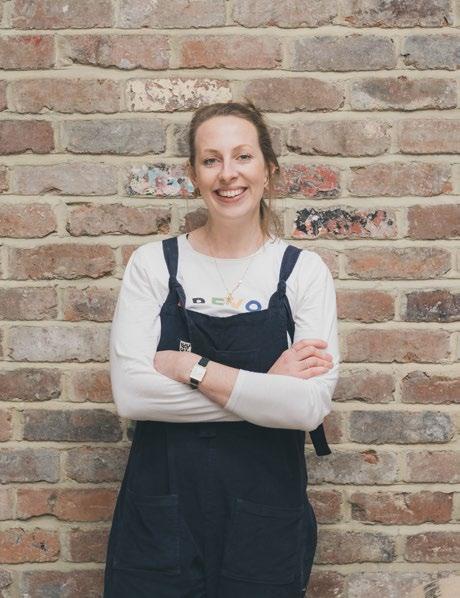
PEOPLE COME
NITY;
POULOS
HOLLY KRAGIO-
north star, leeds CELEBRATING TEN YEARS OF LA MARZOCCO UK 80
interview by JAI MCINTOSH
COME OVER COFFEE.
JAI North Star are considered as one of the most significant coffee houses and roasters in the north of England. Who is North Star?
HOLLY North Star is a coffee company established in 2013 as a wholesale cof fee roastery, supplying speciality coffee, equipment, and training to hospitality businesses throughout the UK. We now have a bakery and a collection of shops. What we try to do is utilise our position within the supply chain to try and build a coffee industry that works for everyone involved. We focus on our supply networks, identifying sustainable partnerships and solid relationships - we also want to communicate this to the consumer and increase cohesion throughout the entire coffee process.
Myself, I have a background in coffee sourcing, tasting, and approving. As we have grown, I end up doing a bit of everything (laughs). We now have a team of thirty people, so I spend my time devel oping strategies and helping them out - I have also just had a child so I am resting up right now!
JAI How is your desire for a unified coffee community in line with the La Marzocco UK philosophy?
HOLLY Coffee is community; people come together over cups of coffee. You also have the global community that forms across the supply chain. What brought us into this industry is knowing we could work in the UK whilst being connected to people all over the globe. Community is central to everything, whether you're a coffee shop that did outstanding things through out lockdown; whether you’re a roastery, there are many moving parts that all work together for the same end goal.
north star, leeds
PEOPLE COME
La Marzocco, like us, work within the speciality space, and building communi ties within this world, few businesses have been as integral as La Marzocco. The way they have helped the UK as a whole is great, but what they have done in the north, and the work our two businesses have put in to bring people together, we have built a vital partnership.
JAI How has the coffee community, the speciality community, developed since 2012?
HOLLY The scene is unrecognisable. We were the first coffee roastery in Leeds which is crazy to think - the country’s third largest city didn’t have a roastery before! We had to work so hard to convince peo ple that joining our journey would be far better than drinking instant coffee.
I grew up in Australia, drinking flat whites as a kid, fully indulging in the coffee cul ture there. When I came back to the UK, there was nothing like it. Finding espres so-based coffee in the UK before 2012, especially in the north, was extremely dif ficult. Now, having gone through lockdown, it is clear that the people and the product unite people; coffee is an affordable luxury that people are willing to explore. The in dustry is in a perfect place to grow despite the various social challenges that are presenting themselves.
JAI How has your experience as a female leader within a previously male dominated field impacted you?
HOLLY I have had a wholly positive expe rience, there have been a few times I have been aware that I am the only woman in the room, but other than that I have been happy. Actually, having spent so much time in various countries where coffee is
sourced, I realise more so that being a white woman is different to being a woman of colour, especially within the larger world of coffee where a lot of integral people are not rewarded for their work at all.
However, here within our communities, the amount of women now working here and considering careers in coffee has grown massively, it is wonderful. Women are real ising that this is an industry that is an ideal space filled with wonderful people.
JAI How do North Star plan on continuing to elevate and build upon the local and national speciality coffee community?
HOLLY A lot of what we are planning is still in theory, things that have not been done before. We now have the headspace to reevaluate and work on what we need to be doing and who we need to support. In terms of how La Marzocco fits into this, they are the only equipment supplier we work with because we believe in their qual ity product, which allows us to showcase quality coffee to new and existing custom ers. This process encourages intrigue.
We aim to be visible at events, hosting events, and working on community pro jects. We are in a place now where we can realise these plans, we have a great team who have worked so hard for a long time to make sure we are in a strong place. We want to be a guiding star for coffee in the north (laughs) - I had to do it! We want to be the space for bringing people together, and we will do that and be there for our community to support them through their coffee journey.
81
northstarroast.com
COFFEE IS COMMUNITY; "
TOGETHER OVER CUPS OF COFFEE.
North Star's Holly Kragiopoulos is out to unite the world and bring people together, one bag of beans at a time
Having swapped the picturesque city of Florence for the woolen skies of Manchester, Amine Moukdi feels as close to home as he ever has
JAI Interestingly, you’re originally from Florence, having worked in the La Marzoc co factory in Italy before moving to the UK. How was this experience?
AMINE Yes, I am from Florence. Well, it is a little town near Florence, but we say Flor ence to make life easier. I used to live very close to the factory, perhaps a five-minute walk. I started to work there in 2013, work ing in production, and doing factory work. This I did for nearly three years, doing all sorts of jobs throughout my time. For ex ample, I worked in the frame department, testing, and electronic departments.
It was beautiful working there. From the first day, I was happy, you can just feel the familial feeling which I know sounds cliche. La Marzocco was a small company before 2009, with about 15/20 people working there. I have been able to see the com
pany grow, from 2012 onwards, where the company has developed at a rapid rate. In comparison to how it is when I started, I was number 42, and I guess nearly 800 people work for the company overall.
JAI Why did you want to work for La Marzocco, and why have you stayed for so long?

AMINE I feel a part of the legacy now, I feel connected to the company and what we are doing. I am a part of La Marzocco now. I have a family heritage in Morocco, and we have the Lion of Africa. Marzocco is the symbol of Florence, I was connect ed from the beginning without realising. I was granted an opportunity, and have met some amazing people. For me, I don’t even feel as though I am working, it is such a great place to work, both in Italy and in the UK.
amine moukdi
For me, it is a beautiful reality to work here. I can see my machines all over the world, and being able to recognise them through tiny differences in detail is amazing. I see machines everywhere and it is actually such a great feeling. The company actually cares about people, and we aim to build a lasting family.
JAI So what encouraged you to move from Italy to the UK and maintain your position with La Marzocco?
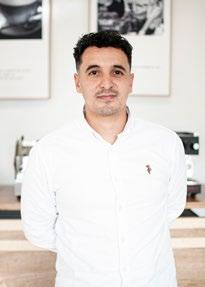
AMINE In 2016 I was asked if I would like to head to Melbourne and build a machine at an event, from the frame to the finished product - kinda crazy. I was with Roberto Bianci, I always bothered him (laughs), I was always asking to do new things, and I love it. I think that is a good thing though. After working in the after-sales depart ment in Italy, controlling services such as training people, and going to various countries to look after machines - I started shadowing people and presenting training displays.
The next step was to find my own part of the world and conduct after-sales from Italy, and travel to various places. I have a wife and daughter, with another on the way. My wife wanted to move to the UK. She is a Russian from Italy who loves the UK (laughs). I asked if there was any
I can see my machines all over the world, and being able to recognise them through tiny differences in detail is amazing.
"
interview by JAI MCINTOSH
TEN
OF
photography by ROSIE LOWERY
CELEBRATING
YEARS
LA MARZOCCO UK
82
chance I could move over and work in the UK. They encouraged me to talk with Paul Kelly, and plans were built from there. In the UK, people work faster and longer. In Italy, we are a little more relaxed. The branch in the UK is so fast, and what I have learned from the last three years would have taken me ten in Italy. I have seen everything about this business, I have a great perspective now which is only en hanced by the way people have helped me adapt to life here. I didn’t even speak the language, they helped me a lot.
JAI The sense of collectivity and com munity within the company seems to be central to the company's DNA, right?
AMINE We have always had a strong community, you enter a family when you work here. You have the chance to learn new things, and you’re allowed to learn, you’re encouraged to improve and grow. I remember when I started, it was beautiful to see Piero Bambi just making coffee, and fixing the grinder. So beautiful. I loved to see the factory empty, and then see how it looks when everyone is in there - I wish I could go back in time to when it was much older and see what it was like. The commu nal culture has been there from the begin ning, and will be there for the entirety of La Marzocco’s lifetime.
JAI So, the last time we spoke, you were the only person to choose a flat white over an espresso as your favourite coffee. Is that still the same?
AMINE Flat white is still an excellent drink, especially in the mornings, but it is not better than a clean espresso. I enjoy both. We also drink a lot of filtered coffee too. The coffee in Italy is not always as good as some think. In the UK, people are more re ceptive and want to try to make things as refined as possible. People here are more open-minded, Italy is very traditional when it comes to food and drink, so changing their minds is difficult. In the UK people like to try new things, it is a very welcom ing trait. I am the same, I love trying new things, although I do love something a little traditional.
Coffee breaks happen all the time in the factory - you could see anyone and they would ask you to go for a coffee, to have a break and have a conversation. It is around 8/9 a day, all espresso. Now I have less coffee, a flat white in the morning, or I’ll have filter coffee - maybe four or five a day, but it is less than before. We all love coffee here.
uk.lamarzoccohome.com
THE THREE C'S: CIDER, CHAMPAGNE, & COFFEE.
Freddie McArdle is best known for his work in the music industry, doubling as trusty Tour Manager and Head Barista for the likes of Mumford & Sons, Lianne La Havas and Joy Crookes. Yet, as the Covid lockdown dawned, Freddie along side close friend and Mumford bassist Ted Dwane began to take their interest in cider making, a little more seriously. Now, utilising the champagne method of production, Freddie is working on perfecting and elevating his cider. Well, when he's not manning his La Marzocco machine out on tour, fuelling any and everyone lucky enough to stumble across his coffee laden path.
Speaking to Freddie in his New York hotel, his love of music is undeniable, but his love of cider, and the process of refined creation, might just take top spot...
ON CIDER
The cider project is a new venture for myself and Ted Dwane, we decided over lockdown to make champagne method cider, and we have been working on making it a viable busi ness since.
We try to make our cider refined, more beautiful, it gives a far greater experience. We have developed our orchard portfolio, we are making sure the correct processes are in place. We are three years in, but it is a three year turnaround from picking the fruit to having the finished product. We are aiming for early next year to release our first fully finished product.
We opted to use the champagne model because of our background in wines, more of an interest than any thing. Ted started making cider first, we have known each other for years as he is the bassist in Mumford and Sons, and I'm their tour manager. We used to talk about it on tour a lot. My grandma has an orchard which meant I had access, so that was where it all started. We employ a lot of winemak ing techniques in our cider making.
Cider is full of history, and there are many ways to make it, we just wanted to try and elevate it as best we can. In the UK, cider is seen as scrumpy or as a commercial super-sweet ‘fake cider’ that is often found in most bars.
Using techniques found in what are normally considered higher-quality products, it is essentially the most elaborate thing you can do with an apple.
ON COFFEE
I end up being a tour manager/baris ta most of the time. It is a total luxury being able to take the machine on tour; the industry is fuelled by coffee, as are most in all fairness. However, as the culture has developed, people are willing to invest in a finer experi ence, especially with something like coffee that can change so dramatical ly depending on the quality.
Paul and I connected seven or eight years ago, he and I got along really well and basically told us to take the mini on tour. It is an amazing piece of kit, so many things get broken when touring but the machine has actually lasted through the years, it is amaz ing. People now like to come and see us backstage sometimes just for the coffee (laughs).
I go pretty deep into subjects if they pique my interest. My uncle was in the wine trade when I was younger. We grew up discussing wines at Sunday lunch, he would have all of these sto ries that explain so much more about what ostensibly is just a drink. This has transferred for me into my love of quality coffee and quality cider.
@twoorchards
83
1920S JAZZ BAR MEETS NOBU, IN HACKNEY
There is a brilliance to consistent inconsistency, a brilliance certainly found on Kingsland Road, Dalston. A locale embodying this more than most, from the architecture to the mishmash of cultures, classes and people found there. Where, hardware shops, and bookmakers are as likely to be frequented as influencer-lad ened flower markets and extortionately priced coffee shops. It is here brothers Amit and Aneesh Patel have created their own cor ner of London, with previous successes Brilliant Corners, roaming Soundsystem setup Giant Steps and bar-come record shop Idle Moments.
The brother’s crusade to bring the highest quality sounds to East London seamlessly continues with their latest venture, mu (see Don Cherry). A Japanese robata grill-inspired bar-restaurant that certainly doesn’t detract from the brother’s musical mantra. The restaurant centres around delivering live music nightly, from local acts and talent in a dimly lit, immaculately furnished environment. Think 1920s jazz bar meets Nobu, in Hackney. Yet, perhaps nostal gia for jazz bars and clubs of the past came from the theatrics, the history, and the very soul in the walls. A soul which mu may not have yet found, albeit tricky to capture.
Music and settings aside, mu’s menu looks to elevate traditional Japanese ingredients within classic dishes. Dishes which could be forgiven for teetering dangerously on the verge of anglicisation by mainstream outlets. The chefs at mu combat this by bringing to the fore essential Japanese flavours of yuzu, miso, nori, and wasabi as well as lesser-known flavours such as nikiri, yuzu kosho, juntoro, wafu, and goma dare. The result is a menu deep in varie ty, elegance and balance.
The truly exceptional dishes mu has to offer were those which championed quintessential elements of Japanese cooking, sim plicity and delicacy. The likes of oyster mushrooms with garlic and soy, raw yellowtail, yuzu and pomegranate together with supple scallop skewers with yuzu kosho. Each harnessing a clarity and skillfulness of cookery whilst maintaining the ingredients at cen terstage. At this point, it should be stated that the wines available are exquisite. The selection was undoubtedly a bona fide labour of love. Pure joy reflected.
Ultimately, mu works, the food works, the music works, and the venue works. There are superb elements honed in Brilliant Cor ners and Idle Moments evident in mu, a consistent grace, quality and refinement. However, inconsistencies in service and demean our may have deterred this opinion ever so slightly.

SOCIAL
WEB
ADDRESS
Rd,
84
mu.ldn
mu-ldn.com
432-434 Kingsland
London
WORDS BY CAL SMITH
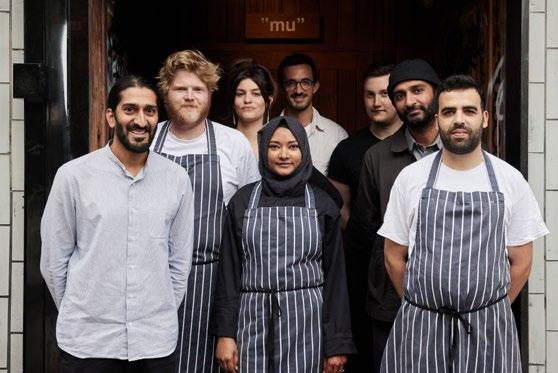

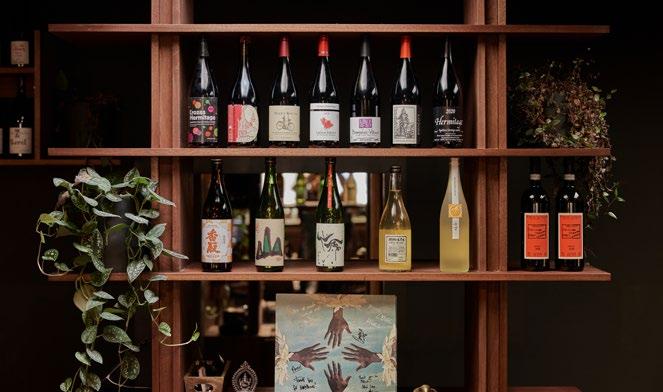
85
WORDS BY BETH BENNETT
If you could drink a myth, what do you think it would taste like?
This is a question I posed to the rest of the Vanilla Factory inhabitants at our EJ offices. It was signalled, as many things are, by an email. An email from Tomatin Distillery up in Scotland who were finally releasing the holy grail of singlemalt fanaticism: The Shirakawa 1958. “The rarest whisky in the world” – and they wanted us to try it. So we did.
A HOLY GRAIL. ON THE ROCKS. WITH A TWIST. A HOLY GRAIL.
If you could drink a myth, what do you think it would taste like?
This is a question I posed to the rest of the Vanilla Factory inhabitants at our EJ offices. It was signalled, as many things are, by an email. An email from Tomatin Distillery up in Scotland who were finally releasing the holy grail of singlemalt fanaticism: The Shirakawa 1958. “The rarest whisky in the world” – and they wanted us to try it. So we did.
ON THE ROCKS.

86
IMAGES COURTESY OF TOMATIN DISTILLERY CO.
BY BETH BENNETT
Before I tell you the answer, I think it’s prudent to provide context. Why is this the rarest whisky in the world? Why does it have a mind-boggling price tag? And, moreover, how can a ‘whisky’ be a myth?
Daikoku Budoshu established Shirakawa Distillery in 1939, just North of Tokyo, with the ethos to create the finest Japanese spirits. It was then purchased, in 1948, by Takara Shuzo and the following decade saw Shirakawa thrive as one of the first distiller ies in Japan to produce malt whisky. However, dark spirits weren’t as popular an export to The West as clear spirits such as sake and vodka, so Shuzo changed the distillery’s direction and moved away from craft whisky altogether by the end of the 60s, of course missing that boom that came about in the 80s.
By the end of the 1900s, Shirakawa was nothing more than a bot tling facility and eventually closed its doors before being demol ished in 2003.
However, this wasn’t the full-stop ending for Shirakawa that many thought it would be. Existing in anecdotes, fractured information, and hand-me-down whispers, rumours lingered that, somewhere a distilled cask of one of Shirakawa’s oldest batches had been moved to a location elsewhere in stainless steel tanks and was waiting to be found.
This piqued the interest of Stephen Bremner, Managing Direc tor of Tomatin Distillery, who’d always had a keen interest in the history of Shuzo’s earlier production. Like some sort of Arthu rian legend, Bremner pieced together every piece of evidence he could, crafting a treasure map that led him, in 2019, to finally unearth Shirakawa’s 1958 Single Malt.

Of the discovery, Bremner had to say: “When I discovered that the last remaining stock was distilled in 1958, I was astounded! It was a genuine ’wow’ moment as I realised very quickly that what we were dealing with was extremely rare. There are no known exam ples of Japanese whisky claiming to be from a single vintage that predates the Shirakawa 1958.”
Due to the confounding history of the whisky, the process can never truly be replicated, making it a finite resource, legitimising its mind-bending £25,000 price-tag. Only 1500 bottles exist and we were fortunate enough to get the opportunity to try a small sample of one of these bottles.
Even if you were to drink this whisky with no understanding of its historical context or the legacy it evokes in the whisky world, you’d still get that sense of the expansive space and time it has travelled as the flavour experience is a transportive one.
The smoothest whisky that you’ll ever drink, it starts off with a heady, wooden taste, unique to that Japanese oak, that moves over your tongue in a bold yet undemanding sort of way. It then settles, comfortably, at the back of your mouth with an almost sweet, citrusy flavour that forgoes the domineering burn found in most single malts for a lingering, playful sensation instead.
Shirakawa 1958 is full of character, eloquently balanced, and vi brant. With a mythic legacy spanning continents and generations, the multi-faceted spirit has cemented itself as a firm favourite of all of us and we’ll be holding onto the little remaining sample we have left to celebrate our most important milestones. After all, could there be a better drink to celebrate with?
87
WORDS
AYO PANTRY ADEYEMI
WORDS BY AYO ADEYEMI PHOTOGRAPHY AKOKO
Welcome to the Essential Pantry, a place for some of the very best chefs to place their favourite ingredients and a recipe around them.
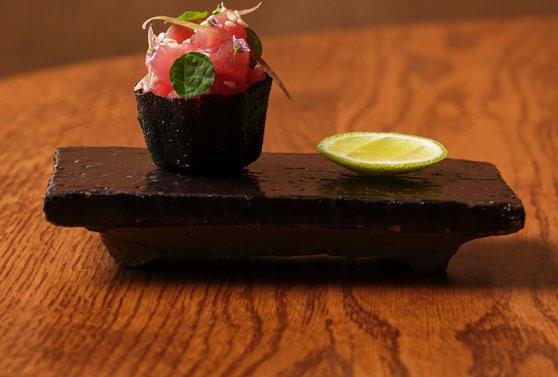

AKAMI TATASE &
ESSENTIAL
88
TATASE & AKAMI
Tatase (Yoruba term for bell pepper) is one of the most commonly used ingredients in West African kitchens and has become an integral component in local West African cuisine. This is heavily used in our kitchen at Akoko for the bases of many of the sauces we make, which is where the idea of this dish came from.
We have taken the juice of the pepper to make the croustade shell, and have also used scotch bonnet to create an acidic smoked ketchup, as well as add sashimi grade tuna to compliment the relish with toasted benne seeds.
INGREDIENTS
Serves 4
For the Miyagawa dressing:
120g Mirin
30g Rice vinegar
100g Olive oil
150g Miyagawa juice (or tangerine)
70g Soy sauce
10g Ginger (slice)
10g Sesame oil
For the Smoked Tatase ketchup:
2 Red onions (finely sliced)
4 Red peppers
50g Red wine vinegar
75g Sugar
1 tsp Scotch bonnet paste
100ml Water
METHOD
For the Tatase relish:
1 Red pepper
2 Pieces of Piquillo pepper (tinned)
Tatase ketchup (as needed)
Salt and pepper to taste
To finish:
50g Tuna loin (sashimi grade)
4 Pieces of croustade shell
Toasted white sesame seeds
Start with the Miyagawa dressing by placing the mirin, vinegar, Minagawa juice, a soy sauce and ginger into saucepan and bring to the boil. Pour into a mixing bowl and allow to cool down. Whisk in the oils until fully incorpo rated. Put to one side.
Now turn to the Smoked Tatase ketchup. Char the skins of the red peppers under a hot grill or by using the open flame of your gas hob. Deseed and finely slice.
Gently sweat the onions and red peppers with pinch of salt until translu cent. Add sugar and deglaze the pan with the vinegar. Reduce all the way and add splash of water until everything is soft.
Blend in food blender until smooth and pass through a sieve. Season to taste.
Now for the relish. Do the same as before and torch the peppers over a naked flame to blister skin then peel the skin once cooled and deseed. Semi dry for 4 hrs in the oven at 100°c.
Finely chop down and dress with olive oil, the ketchup and season to taste.
Cut the tuna loin into small cubes (0.5x0.5cm).
Dress the tuna generously with the Minagawa dressing, a pinch of sesame seeds, and salt and pepper to taste.
Fill the croustade shell halfway with the tatase ketchup, and then top the remaining with the tuna. Finish with some lime zest and optional lime juice.
ESSENTIAL
"This is inspired by my mother, who had created a relish as a condiment, very similar to this recipe, to accompany her homecooked rice and stew dishes, just to add a touch of heat and sweetness."
@cincinuk
89
COLUMN
VENTRILOQUISTS, VOYEURISM, AND THE VAUDEVILLE
WORDS BETH BENNETT
90
What happens when you die?
For most of us, we exist in photographs, videos, and memories that get passed down for a few more generations throughout our lineage and then… well, I don’t mean to evoke nihilism right now, but we get forgotten. It’s inevitable. It’s a fact of life as sure as death: one day you will be completely forgotten.
However, Fame and Infamy will tell you differently. And it so happens that what they’ll tell you will be the same thing; only Fame is a platinum blonde bob of a persistently puppeteered performer and Infamy is the aviator glasses of a celebrated crazed cannibal.
The infernal movie-making machine has, once again, resurrected Marilyn Monroe and Jeffrey Dahmer for our viewing displeasure. Netflix’s ‘Blonde’ is preoccupied with sending a mere shadow of Monroe through some warped Stations of the Cross before her self-crucifixion with little regard for much else beyond suffering. Meanwhile, not one swipe along on the Most Watched, Netflix’s Dahmer egregiously shows the viciousness of a man hell-bent on causing suffering to young, predominantly black, gay men, favouring shock and disgust over pretty much anything else. In both these pieces of media, what we’re seeing is the latest instalment in the exploitation of historical victims. Fame shatters Monroe into eternal self-flagellation, god-like; whilst Infamy places the Devil on a pillar of supposed humiliation that feels a lot more like celebration.
This isn’t new. Not by any means. How many Famous pioneering creatives who succumb to a tragic, masochistic end can you think of? Or how about the Infamous Jack the Ripper books/films/shows since the 19th Century talk of a man killing women working in Whitechapel? Or, if we look even further, the Infamous colonies dragging Africans on a boat to strip them of their being for all eternity. We reserve empathy for the Famous and disgust for the Infamous. Or do we?
Empathy, one may wager to say, is a thin laced veil over the warped enjoyment we have to observe suffering. The actors and the film itself, becomes a conduit for our deepest inhibitions. There’s a pleasure derived from it, whether it be a somewhat privately smug realisation that your life isn’t that bad; or some enjoyment encouraged by your id at seeing terrible awful things. Laura Mulvey said it best: “The position of the spectators in the cinema is blatantly one of repression of their exhibitionism and projection of the repressed desire on to the performer.”
But we’re dealing with stories of real people. These are then projected in a CinemaScope that deviates with artistry and with each rehashing thwarts our empathy even more so. An endless cycle, powered by Fame and Infamy, that culls our humanity with every turn. When will it be enough? When will our repressions and our pleasures be appeased?
They won’t, frankly. The cycle will get more vicious to make them happy and those caught up in it will exist, eternally fractured, because of us.
91
COLUMN
THE EVOLUTION OF THE CUBAN LINK CHAIN
WORDS ROHIN JOHAL
92
From consistent references in rap lyrics, to adorning the runway stars, and even into the villages nestled into the Indian country side, Cuban link chains are vastly popular amongst people from all walks of life. From Travis Scott to your iced out uncle, the evo lution and emblematic significance of the increasingly accessible Cuban link chain highlights that the demand for such items is, if anything, continually increasing.
Although the origin of the chain is unclear, they started popping up all over the United States, especially Miami in the ‘70s whilst also making headway in the Bronx too, rapidly gaining popularity within the HipHop culture of the time, with key individuals such as Slick Rick and DJ Kool wearing them. In the ‘80s we saw the chains develop in a defining look for the group Run DMC with the infamous ‘dookie’ chain. In the ‘90s with the likes of Biggie and Tupac sporting the chains with their baggy jeans, leather jackets and, of course Tupac’s bandana. The Cuban link was now a firm staple.
They are now more commonly worn by art ists like Jay-Z with his five kilogram Miami Cuban link costing him $200,000 - how he has the endurance to wear it over the span of a day is beyond me. Today, the Cuban link still embodies wealth and luxury, stemming from Hip-Hop and evolving into a mainstream consumer demand. Nota bly, Jean Paul Gaultier incorporated the chains in his FW 2013/14 couture look. With impressive detailing and unique sizing, Gaultier demonstrated how Cuban links can be styled for the Avant-Garde of the fashion elite whilst remaining a key part of Hip-Hop culture.
But what about the common man? What about someone that doesn’t have the wealth of these global superstars?
Today there is a whole assortment of met als, styles and price tags that are making Cuban link chains more accessible. Gone are the days of flaunting the biggest and heaviest chains - although Daddy Yankee wouldn't agree with his 10 kilogram chain - as jewellers across the globe are better able to supply consumers with something that is more tasteful that won’t break the bank.
The significance of the chain is displayed when observing the rapid rise of wealth amongst prominent rappers, which, throughout the ‘90s up to the present day, is a common theme in contemporary cul ture. However, a Cuban link chain acts as a saddening reminder that wealthy artists of colour at the time had to flaunt their wealth to prove their success, something seldom experienced by their white counterparts, a theme across industry. Also, the chains have become emblematic of the continual struggle black and brown communities experience, the wearing of a Cuban link is the reclamation of manacles and chains that have historically afflicted these com munities.
With more people wearing Cuban link chains, their command and stylistic signif icance within the spheres of fashion and general society are far from dissipating. Touching base with the thematic signif icance of these chains, it is clear they represent two very contrasting aspects of life; they will make people walk around with a bit of added swagger in their step but also a serving reminder that coloured communities across the globe still have the need to flaunt success and wealth, a state of being we desperately need to move on from.
93
WORDS EMMY HALLAHAN
WHEN DID YOU LAST SEE YOUR
94
FRIENDS? COLUMN
It’s about this time of year where I inevita bly wake up one morning to find my brain, much like the pigeons that nest on my roof, has taken flight. Unlike the pigeons, however, it’s left with little fanfare, and has no sign of returning.
Maybe it’s been drowned by our seemingly endless rain, or caught up in the gale force winds that spent a good few weeks batter ing us. Maybe, it’s a classic case of seasons changing, sunlight waning. Regardless of what’s caused it, there is seemingly only one solution. It’s a simple one, yet one that I forget without fail, every year. Go out and socialise, you miserable bitch.
This time of year, in the run up to winter, and - dare I even say it, this early? - Christ mas, everyone becomes preoccupied. The long summer nights are gone, and the days in which it’s warm enough to even think of suggesting a pub garden have gone with it. The idea of going straight home to a cosy bed wins out over the promise of the wildest of nights. That, or I’m just getting old. I’m only twenty twounless you’re that one woman in Clapham Sainsbury’s that genuinely refuses to believe me, but I digress - yet I’ve adopt ed the habits of my grandparents. I head home straight after work, eat dinner, and go directly to sleep until I wake up for work again the next day. Repeat ad nauseam, until you wake up one day feeling like you’ve forgotten how to hold a conversa tion. When did you last see your friends?
After asking myself that, I embarrassingly, some exceptions aside, had to conclude that it may have been way back in August, July, or even June. Perhaps I’m generalis ing here, but I’m beginning to wonder if this is a pattern, if this is something we all face once the sun starts setting earlier. And if we are all prone to this, are we all just awk wardly ignoring each other and running on home the second we get a chance?
It’s a pretty rough time of year to not be around people you’re close to. It’s dark, and cold - colder than ever thanks to this ongoing energy crisis situation - adding loneliness into that mix is a recipe for dis aster. So, don’t. Ask your friends to come over for a takeaway, suggest a pub visit, watch the footie, go shopping, whatever it is you like to do together - and stick to it. Tell them you’re looking forward to it, that you want to see them. It’ll make you feel better, and it’ll make them feel better. Hey, you never know - you might even have a better time than if you sat at home by yourself.
Personally, I think you should promise me right now that you’ll reach out to your mates, yeah? I won’t know if you actually promised, because I only have two pinky fingers and presumably there’s going to be more than two copies of this so I can’t amputate them, but I won’t tell if you won’t. Stop being a miserable bitch, and pick up your phone. Talk to people. Go outside. You probably won’t regret it.
95
COLUMN
FINDING YOUR FIT
WORDS LOUIS BENEVENTI
My stomach turned. The idea of going on a website to shop for clothes which always had the connotations of awful fashion for the larger gent made me nauseous. The bead of sweat rolling down my forehead felt cold on the warm June morning as we drove through suburban London to a family function. I, knowing full well that food would be on the table that had been prepared by my cousin, an Italian who has over 20 years in the restaurant trade in London, and a Michelin star, could already feel my suit trousers wincing.
“Fucking Jacamo?” The car went silent and that, ladies and gentlemen, was that.
Or so I thought.
Fast forward a few months, and some friends of mine are getting married. A Best Man wasn’t on the agenda, but unofficially, I was given the role by my friend. What an honour! I was told to get
out my finest, bring some Italian sartorial elegance to the affair, and I was going to oblige by doing my best impersonation of Tony Soprano. It’s in the genes. Oh I forgot to mention, this was post-lockdown Britain; I couldn’t fit into my jeans, let alone my suit.
So, the hunt was on. It was a destination wedding and delivery times would be cut ting it fine, so I fired up my laptop and took to the internet like a duck to water. Sorry, did that read as duck? Auto-correct.
The internet was a hellscape. At one point, I was contemplating if I’d have preferred to take a walk in 2003 Basra. What started on Moss Bros. went on and on as I scoured the internet for the perfect suit. Marks and Sparks? Nah. ASOS, nope. BooHoo? Abso lutely not. Basra was looking tempting…
I took a deep breath. I grabbed my glass of Campari and soda, and typed it in.
Jacamo. There it was. A blue, double breasted, Prince of Wales check suit.
It was beautiful, I wanted to cry, but I wasn’t sure if that was because of the al cohol, the fact it was 3am or if I was in love. Turns out it was all three. The wedding rolled round, and I was there doing my best impersonation of a manager before the Champions League final with my pal, feeling the business, and reminding him to enjoy the moment, a la Mourinho. Ultimately, I felt confidence and assurity in my attire, a feeling increasingly important as we navigate the stringent demands on contemporary society. The wedding was a success, perhaps due to my suit.
Bottom line is this; as a bigger guy, it’s not impossible to look good, and you shouldn’t let it stop you from exploring different places to get your style on point. You can feel confident in what you wear, and people’s idea of brands shouldn’t stop you from finding your fit. Yes it’s more diffi cult in today’s world with perfect bodies on Instagram, but fuck it. Ryan Gosling is overrated. Find your style, whatever your size.
“Have you thought about shopping on Jacamo?”
96


WITH YOU ALL THE WAY
Whether you’re working with an architect and interior designer to create your dream home, or are planning a stylish conversion project, or require retrospective cover for a new build property, a structural warranty will give you the peace of mind you need to enjoy your new abode to the fullest
Advantage Home Construction Insurance, which has its headquarters in the North West and offices throughout the UK, is a leading provider of structural warranties and is trusted by individual self-builders and leading developers alike.

BENEFIT FROM HAVING A DEDICATED RELATIONSHIP MANAGER
Our dedicated relationship managers have a reputation for going above and beyond, whether they’re working with one of the nation’s largest property developers, or with a home owner who’s embarking on their first self-build or renovation project.
We work with leading rated insurers and have 40 years of experience in our sector. Advantage is also part of Trading Standards’ Consumer Codes Approval Scheme,meaning that our company has a ‘proven commitment to honest business and higher customer standards.’
We are known for being proactive in our approach, helping move projects of all sizes forward and for giving our clients peace of mind at every stage of the development process. We’re with you all the way.
DO YOU NEED A STRUCTURAL WARRANTY?
Structural warranties provide cover if a structural defect is detected within 10-12 years of your project being completed, and if you own a new build home which is not already covered by a suitable structural warranty, you will need one in order to sell the property.
If you’re thinking about converting a property for residential use, then you will also need to consider structural defects insurance.
Every conversion requires latent defects insurance to protect you and your newly renovated property.
To discuss your requirements or to request a quote:
Call us: 0845 900 3969 Email us: sales@ahci.co.uk or visit our website: ahci.co.uk
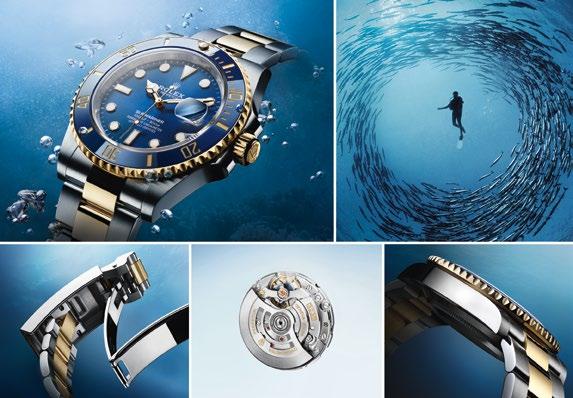




















 BY JAMES TIPPETT
BY JAMES TIPPETT

 BY DAVID CONN
BY DAVID CONN
 BY JONATHAN WILSON
BY JONATHAN WILSON













































 WORDS BY ROB PRATLEY
WORDS BY ROB PRATLEY

















 BETH BENNETT
BETH BENNETT


 WORDS BETH BENNETT PHOTOGRAPHY HAYDEN BLAZ
WORDS BETH BENNETT PHOTOGRAPHY HAYDEN BLAZ





























